new posts in all blogs
Viewing: Blog Posts Tagged with: Native American, Most Recent at Top [Help]
Results 26 - 50 of 73
How to use this Page
You are viewing the most recent posts tagged with the words: Native American in the JacketFlap blog reader. What is a tag? Think of a tag as a keyword or category label. Tags can both help you find posts on JacketFlap.com as well as provide an easy way for you to "remember" and classify posts for later recall. Try adding a tag yourself by clicking "Add a tag" below a post's header. Scroll down through the list of Recent Posts in the left column and click on a post title that sounds interesting. You can view all posts from a specific blog by clicking the Blog name in the right column, or you can click a 'More Posts from this Blog' link in any individual post.

By:
jilleisenberg14,
on 11/9/2014
Blog:
The Open Book
(
Login to Add to MyJacketFlap)
JacketFlap tags:
children's books,
literacy,
art education,
Educators,
Native American,
reading comprehension,
close reading,
Educator Resources,
Common Core State Standards,
CCSS,
guided reading,
ELA common core standards,
Add a tag
I’ll admit it: I was looking for a Native American book by a Native American author to write about in light of Thanksgiving and National American Indian Heritage Month as many teachers do this time of year.
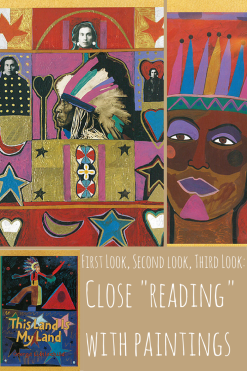 This led me to reread and re-experience the Children’s Book Press treasure, This Land is My Land, by artist George Littlechild. As winner of the 1994 Jane Addams Picture Book Award and 1993 National Parenting Publications Gold Medal, This Land is My Land is a notable treat for students and readers of all ages.
This led me to reread and re-experience the Children’s Book Press treasure, This Land is My Land, by artist George Littlechild. As winner of the 1994 Jane Addams Picture Book Award and 1993 National Parenting Publications Gold Medal, This Land is My Land is a notable treat for students and readers of all ages.
The book features 17 of the artist’s mixed media paintings organized to portray Native American history in North America and Littlechild’s own heritage and childhood. As I studied Littlechild’s paintings and read his accompanying essays about each, I felt as if I were on a gallery walk with my own earbud connected to the artist.
Although this picture book would make a great counterpoint to many Thanksgiving books out there, This Land is My Land is valuable beyond the Thanksgiving-relevant content. It is a great example of how art is a powerful medium for critical thinking development and can be integrated into literacy instruction (not just the assigned art block a couple times a week).
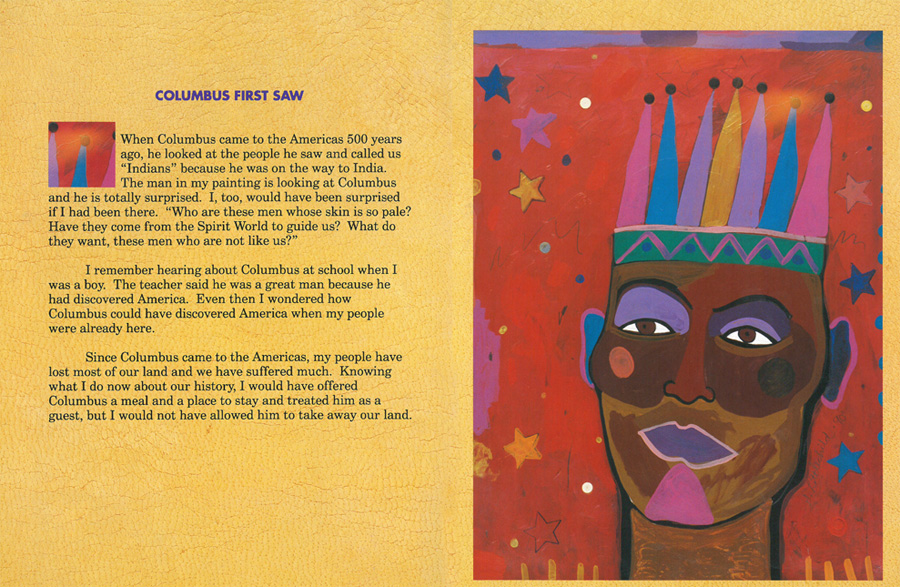
Click on the image to read the text
So, what does close reading (or “looking?”) look like with art?
Like a text, a piece of art is another place for students to engage with multiple times and each time diving into another level of meaning and interpretation. Using art in the classroom relates to the reading standard 7 of the Common Core, Integration of Knowledge and Ideas. Additionally, many of these questions are questions we would use with students in the close reading of a text.
Below is an example of how students can progress with their observations and thinking. I separated levels of questions into three viewings based on level of complexity, but of course one could (and should) return to a worthwhile painting many, many times.
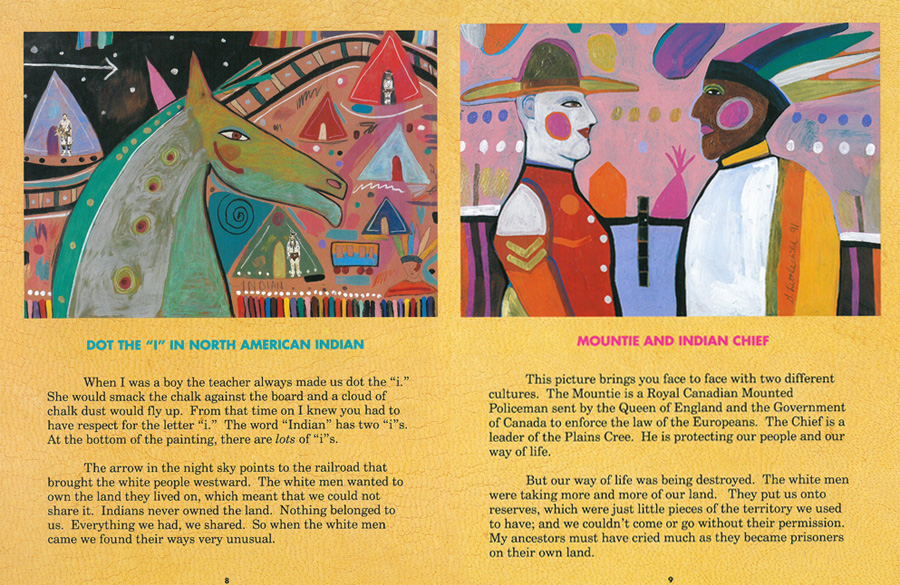
First look (literal comprehension/understanding)
- What is happening?
- What patterns do you see? What images, colors, and symbols do you see repeated or used most often in this painting or across paintings?
- What materials does Littlechild use?
- How does Littlechild use positive or negative space?
- How does Littlechild use the foreground and background?
- Who is the narrator?
- What are some common ideas or events portrayed in his artwork?
- What is the central idea of the painting? What is the central idea of the paintings taken altogether? What makes you think so?
Second look (higher level thinking/interpretation of meaning)
- What effect do repeated colors, images, patterns, or symbols have on his art and the central idea?
- What effect does a specific material, such as shells or sequins, have on his art and the central idea?
- What does “Indian” mean to Littlechild?
- How does Littlechild’s background (childhood, heritage, identity, family relationships) affect the subjects, themes, and materials of his paintings?
- What has Littlechild learned from his elders? What does he want viewers to learn from or think about events in the past and our heritages?
- What is the mood of one piece of the artwork or the collective body of artwork? What makes you think so? What colors, patterns, materials, or images does he use to convey mood?
- What is the purpose of his art? Why would Littlechild create this painting or assemble these paintings into a collection? Why talk about these events and his heritage and childhood at all?
- Who do you think is the intended audience of This Land is My Land? What might Littlechild want them to do with this narrative and perspective?
- How does Littlechild demonstrate pride in and appreciation for his heritage? How does he convey pain in Native American history? How does he convey the closeness of his community?
Third look (higher level thinking/analysis of artist’s craft/structure/methods)
- Why does Littlechild choose to start the book with a dedication to his ancestors and include their photographs?
- How is the collection of paintings organized? How does the chronological structure convey or confirm his central idea? How does this mixed media collection compare to a biography in book form?
- Why does Littlechild choose the title and painting for the book cover: This Land is My Land? He doesn’t like the song, “This land is your land, this land is my land,” or its meaning; so, why does it fit as the title and cover painting for the book? What does this choice tell us about the central idea of the book? What message does he want to convey to viewers?
- Why does Littlechild use photographs in the painting, instead of just drawing the figures? What effect do the photographs have on the story he is telling and on the painting itself? (Repeat this question for feathers, sequins, shells, and feathers)
- Why do you think the artist chooses to use the motif of stars? What do a “star” mean in this context? the number four? horses?
- Why does Littlechild choose art/mixed media collage to represent events in his own life and convey his the central idea?
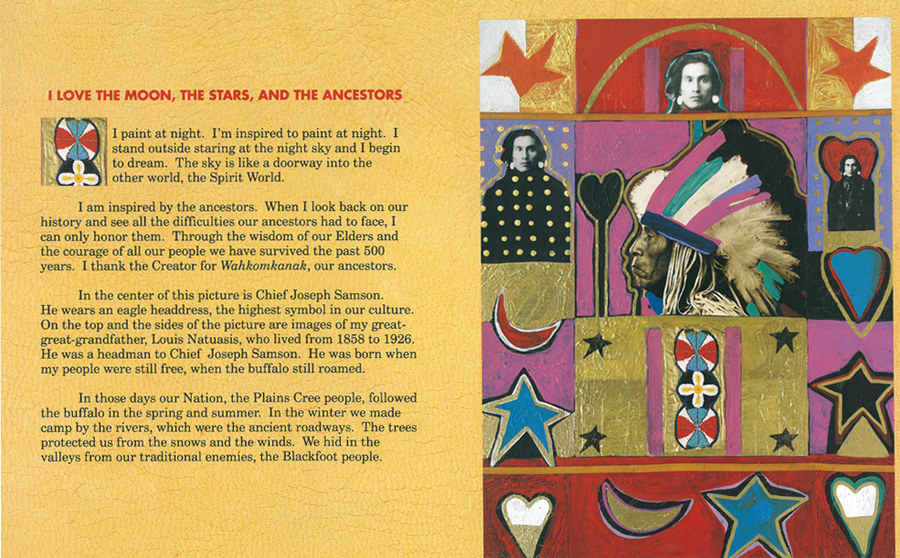
For further reading on integrating the Arts with the Common Core, check out these fantastic resources:
How are you integrating art with the Common Core? What tips do you have for choosing high quality art to teach? What art are you using already? Let us know!
 Jill Eisenberg, our Senior Literacy Expert, began her career teaching English as a Foreign Language to second through sixth graders in Yilan, Taiwan as a Fulbright Fellow. She went on to become a literacy teacher for third grade in San Jose, CA as a Teach for America corps member. She is certified in Project Glad instruction to promote English language acquisition and academic achievement. In her column she offers teaching and literacy tips for educators.
Jill Eisenberg, our Senior Literacy Expert, began her career teaching English as a Foreign Language to second through sixth graders in Yilan, Taiwan as a Fulbright Fellow. She went on to become a literacy teacher for third grade in San Jose, CA as a Teach for America corps member. She is certified in Project Glad instruction to promote English language acquisition and academic achievement. In her column she offers teaching and literacy tips for educators.
Filed under:
Common Core State Standards,
Educator Resources Tagged:
art education,
CCSS,
children's books,
close reading,
Educators,
ELA common core standards,
guided reading,
literacy,
Native American,
reading comprehension 


By:
rgarcia406,
on 10/14/2014
Blog:
The Open Book
(
Login to Add to MyJacketFlap)
JacketFlap tags:
list,
halloween,
diversity,
Joseph Bruchac,
Native American,
Science Fiction/Fantasy,
African/African American Interest,
Multiracial,
Tu Books,
Teens/YA,
Asian/Asian American,
Latino/Hispanic/Mexican,
Diversity in YA,
Lee & Low Likes,
Diversity, Race, and Representation,
Book Lists by Topic,
Add a tag
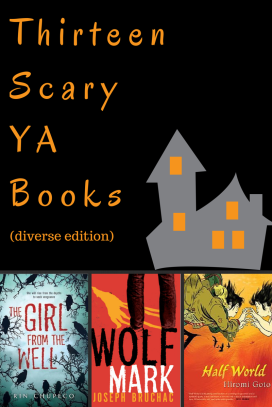
Halloween is right around the corner. There’s no better way to celebrate than by reading books that will scare you to pieces! Here’s a lucky thirteen list of our favorites (all featuring diverse characters or by diverse authors):
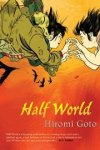 Half World by Hiromi Goto – Melanie Tamaki lives with her mother in abject poverty. Then, her mother disappears. Melanie must journey to the mysterious Half World to save her.
Half World by Hiromi Goto – Melanie Tamaki lives with her mother in abject poverty. Then, her mother disappears. Melanie must journey to the mysterious Half World to save her.- Vodnik by Bryce Moore – Sixteen-year-old Tomas moves back to Slovakia with his family and discovers the folktales of his childhood were more than just stories.
- The Immortal Rules by Julie Kagawa – Allie Sekemoto survives by scavenging for food by day. She hates the vampires who keep humans like cattle for their food. Until the day she dies and wakes up as a vampire.
- Liar by Justine Larbalestier – Micah is a liar; it’s the only thing she’ll tell you the truth about. But when her boyfriend Zach is murdered, the whole truth has to come out.
- Battle Royale by Koushan Takami – A group of junior high school students are sent to an island and forced to fight to the death until only one of them survives.
- Summer of the Mariposas by Guadalupe Garcia McCall – Odilia and her sisters discover a
 dead man’s body while swimming in the Rio Grande. They journey across Mexico to return his body in this Odyssey-inspired tale.
dead man’s body while swimming in the Rio Grande. They journey across Mexico to return his body in this Odyssey-inspired tale.
- Devil’s Kiss by Sarwat Chadda – Zombies, ghouls, and vampires all make appearances in the story of Bilquis SanGreal, the youngest and only female member of the Knights Templar.
- Panic by Sharon Draper – Diamond knows better than to get into a car with a stranger. But when the stranger offers her the chance to dance in a movie, Diamond makes a very wrong decision.
- Ten by Gretchen McNeil – Ten teens head to a secluded island for an exclusive party…until people start to die. A modern YA retelling of Agatha Christie’s And Then There Were None.
- Wolf Mark by Joseph Bruchac – Inspired by the Abenaki skinwalker legend, this YA thriller is Burn Notice with werewolves.
 The Girl from the Well by Rin Chupeco – A dead girl roams the streets, hunting murders. A strange tattooed boy moves to the neighborhood with a deadly secret.
The Girl from the Well by Rin Chupeco – A dead girl roams the streets, hunting murders. A strange tattooed boy moves to the neighborhood with a deadly secret.- 172 Hours on the Moon by Johan Harstad – Three teenagers win the vacation of a lifetime: a week-long trip to the moon. But something sinister is waiting for them in the black vacuum of space.
- Anna Dressed in Blood by Kendare Blake – Cas Lowood is a ghost hunter, called to Thunder Bay, Ontario to get rid of a ghost the locals call Anna Dressed in Blood, who has killed every person who has stepped foot in the house she haunts.
What else would you add to the list?
Filed under:
Diversity in YA,
Diversity, Race, and Representation,
Lee & Low Likes,
Tu Books Tagged:
African/African American Interest,
Asian/Asian American,
Book Lists by Topic,
diversity,
halloween,
Joseph Bruchac,
Latino/Hispanic/Mexican,
list,
Multiracial,
Native American,
Science Fiction/Fantasy,
Teens/YA,
Tu Books 


By:
Jason Low,
on 7/29/2014
Blog:
The Open Book
(
Login to Add to MyJacketFlap)
JacketFlap tags:
diversity,
LGBT,
Native American,
Science Fiction/Fantasy,
African/African American Interest,
whitewashing,
Race issues,
Multiracial,
Middle Eastern,
Asian/Asian American,
Latino/Hispanic/Mexican,
The Diversity Gap,
Diversity, Race, and Representation,
Guest Blogger Post,
Add a tag
Summer blockbuster season is in full swing. For many moviegoers, that means escaping to a galaxy far, far away—or perhaps just a different version of our own planet Earth—through science fiction and fantasy movies. As fans clamor for the latest cinematic thrills, we decided to focus our next Diversity Gap study on the level of racial and gender representation in these ever-popular genres that consistently rake in the big bucks for movie studios. We reviewed the top 100 domestic grossing sci-fi and fantasy films as reported by Box Office Mojo. The results were staggeringly disappointing, if not surprising in light of our past Diversity Gap studies of the Tony Awards, the Emmy Awards, the children’s book industry, The New York Times Top 10 Bestseller List, US politics, and the Academy Awards, where we analyzed multi-year samplings and found a disturbingly consistent lack of diversity.
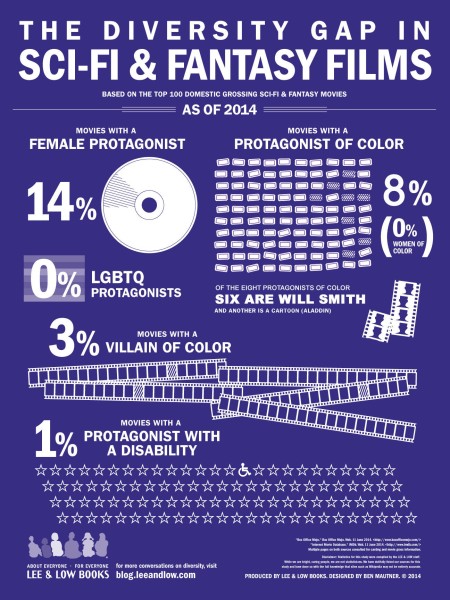
The Diversity Gap in Sci-Fi & Fantasy Films infographic (click for larger image)
Among the top 100 domestic grossing films through 2014:
• only 8% of films star a protagonist of color
• of the 8 protagonists of color, all are men; 6 are played by Will Smith and 1 is a cartoon character (Aladdin)
• 0% of protagonists are women of color
• 0% of protagonists are LGBTQ
• 1% of protagonists are people with a disability
The following interviews with two prominent entertainment equality advocacy groups shed more light on the subject.

Marissa Lee is co-founder of Racebending.com, an international grassroots organization of media consumers who support entertainment equality. Racebending.com advocates for underrepresented groups in entertainment media and is dedicated to furthering equal opportunities in Hollywood and beyond.

Imran Siddiquee is Director of Communications at the Representation Project, which is a movement that uses film and media content to expose injustices created by gender stereotypes and to shift people’s consciousness toward change. The Representation project was the follow-up to the critically acclaimed documentary Miss Representation.
Jason Low: Do these statistics surprise you? Why or why not?
Marissa Lee: The statistics are certainly striking, especially since sci-fi and fantasy belong to a genre that prides itself on creativity and imagination. These statistics aren’t necessarily surprising, since lack of diversity in Hollywood films is a well-known problem. There have been enough studies and articles, and any moviegoer can pause to notice there is a disparity. . . . Hollywood can’t go on pretending that this isn’t a problem.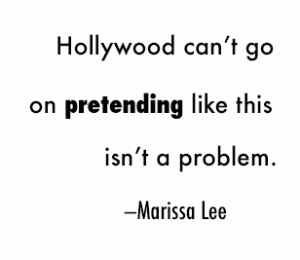
JL: Do you think the American movie-going audience would support a big, blockbuster sci-fi/fantasy movie with a diverse protagonist if a studio made it?
Imran Siddiquee: Yes, definitely. But I think an important thing to understand about Hollywood blockbusters is that they are almost never flukes; they are preordained. Sure, we have the occasional surprise indie hit, but you need a lot of money and marketing behind you to become a blockbuster. Just look at the top ten films in each of the last five years: nearly every single one had a budget of more than $100 million (a lot of them were also sci-fi/fantasy films).
Meanwhile, there hasn’t been a single film released this year starring a person of color with a budget of more than $50 million, let alone a sci-fi film, which is naturally going to be more expensive. The same goes for most of the last decade. So for anyone who might say “people just don’t watch sci-fi movies starring people of color,” or “there’s no evidence that this would work,” the truth is that we have no evidence that it wouldn’t work.
Studios take a couple of massively expensive chances every year on mostly unknown actors or directors—aka giving the Spider-Man franchise to Marc Webb and Andrew Garfield in 2012—but they just don’t take those kinds of chances on people of color. In other words, if Hollywood wanted to make a blockbuster sci-fi/fantasy film starring a woman of color, they definitely could.
ML: I think American audiences would support a film with a diverse protagonist, because we already have. One pullout statistic from your infographic is that Will Smith leads six of the top 100 big sci-fi/fantasy films. His race wasn’t a huge impediment to box office success and may have, in fact, been part of what made him all-American and relatable. That was back in the late 1990s, but since then, Hollywood hasn’t tried to find a new Will Smith. This is kind of ironic, given that Hollywood likes to stick to formulas and sequels! They could push forward another actor—or actress—of color with Smith’s charisma. They haven’t.
The American movie audience supports any movie that Hollywood successfully markets well, especially—but not always—if the film is well produced. Hollywood has managed to market some weird stuff, like a tentpole movie about talking teenage turtle martial artists, or cars that change into space robots, and so on. I don’t buy that when it comes to marketing diverse leads, suddenly this giant industry can’t do it.
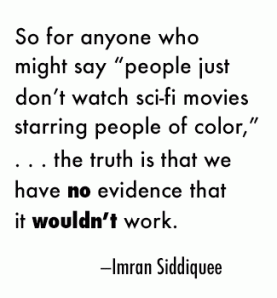 I’d be interested in seeing how many of these top 100 grossing sci-fi and fantasy films star non-human leads. I wonder if there are more films with non-human leads than minority human leads on the list!
I’d be interested in seeing how many of these top 100 grossing sci-fi and fantasy films star non-human leads. I wonder if there are more films with non-human leads than minority human leads on the list!
(Side note: Does the infographic count Keanu Reeves as white or as a person of color? I think he has more than one movie on this list given The Matrix trilogy…)
Editorial note: Yes, Keanu Reeves is counted as a PoC and did make the list for The Matrix. The second Matrix film, The Matrix Reloaded was the only installment of the trilogy to make the top 100 list.
JL: What challenges have you faced or seen peers facing as a woman/person of color, etc.?
ML: There are films with built-in audiences that Hollywood still insists on whitewashing, which has a very adverse effect on actors of color. Let’s be honest, audiences would have still flocked to see The Hunger Games or Twilight if characters like Katniss or Jacob had been cast with people of color as they were written in the books. An actor with a disability could have played the protagonist in Avatar—if we have the technology and imagination to animate a fanciful world populated by blue cat people, we could have cast an actor with a disability similar to the lead character’s in that role. As a result of these casting decisions, up and coming actors from underrepresented groups were deprived of career exposure from being a part of these established franchises, making it harder for Hollywood ever to try and launch a new franchise with an actor from an underrepresented group.
Every single Marvel Studios movie has centered around a presumably straight, white, male protagonist, even if white women (mostly love interests) and men of color (support roles) have played roles in the film. The franchise is a box office juggernaut and has a ton of movies on this list, but we’ve gotten two to three movies about each of the men on the Avengers and there’s yet to be a film about Black Widow. Both of Marvel’s ensemble films—The Avengers and Guardians of the Galaxy—trimmed down the superhero teams for their film adaptations, and the women characters, save for one, were the first to be cut. Most moviegoers will never know that women of color and LGBTQ characters were cut from Guardians of the Galaxy, but audiences will get to relate to the talking raccoon and the talking tree.
More recently, the Divergent franchise cast Naomi Watts to play a character who was a woman of color in the books. It’s a supporting role for an already established franchise, and for whatever reason the production still couldn’t bring themselves to cast an actor of color.
Trends that fans have noted in the media include that in big blockbuster sci-fi and fantasy films, the presence of a straight, white, able-bodied, cis male in some central role in the story is almost guaranteed, while the presence of characters with “minority” identities (e.g. LGBTQ folks, people of color, people with disabilities, women, etc.) is not. Even when a character who isn’t a straight, white cis male is centered in a story, there’s probably a straight, white, cis male character playing second, if not lead, billing. For example, while we can reasonably assume that the next few Star Trek and Star Wars movies will have some diverse characters, we can guarantee that at least one of the leads will be a straight, white man. If The Hunger Games or Twilight had cast actors of color for Katniss or Jacob, there would still have been plenty of lead roles filled by white actors. DC is including Wonder Woman in an upcoming movie, but the film will also feature Batman and Superman.
This means that someone with a lot of intersecting privileged identities (especially straight, white men) will always be able to walk into a multiplex and find a sci-fi/fantasy movie starring someone who shares those identities. If you have a lot of marginalized identities, then representation is a sometimes thing, never a solid guarantee. There is a very small but vocal minority of people who want to maintain this status quo, and Hollywood seems to cater toward them due to institutionalized racism, fear, and habits. But there are just as many, if not more, people who are willing to support, vociferously, films with diverse leads. I wish our money was as good as theirs.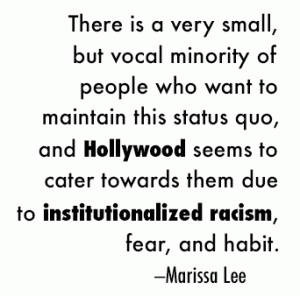
JL: How can consumers encourage more diversity in movies?
IS: Avoid buying tickets to films which clearly rely on stereotypes or demeaning portrayals of people based on gender, race, class, age, sexual orientation, ability, or circumstance. And anytime you do watch a film, give it The Representation Test afterward. The test grades films on their inclusiveness pertaining to all those above categories. When a movie scores really low on the test, use #NotBuyingIt on Twitter to let the filmmakers and all your friends know how you feel. Since so much of this industry is based on money, this is one way we can express our discontent and get the attention of the studios.
ML: Media literacy is a huge start. As media consumers, we should feel empowered to critique the media we consume, and to decide what media we choose to consume. Beyond helpful steps like going to see movies that feature diverse leads, it’s just as important to start conversations in our own communities and with our friends and family (the people we consume media with!) to raise awareness about diversity and representation. Even if we don’t go to see movies that whitewash or exclude or present discriminatory content, people we know will. One way we can help change things is by continuing to start conversations. We need to create an environment where it is safe to criticize popular franchises for lacking diversity. We also need to keep drowning out the malcontents who cannot even handle actors of diverse backgrounds in supporting roles. Social media has really knocked down barriers when it comes to communicating our opinions with Hollywood brass. It’s also given us several spaces where we can discuss the media we consume with our friends and family. In addition, the internet has really changed how we access and consume media. There are Kickstarters and indie channels and online comics and other outlets so we don’t have to be reliant on big production studios or publishers as our only sources of entertainment.
JL: How close or far do you think we are from getting these statistics to change?
IS: When you’re talking about representation that is this low, it’s hard to go anywhere but up. For instance, 0% for women of color in top sci-fi films means I’m being honest when I say things will certainly improve soon, but that’s not saying much. I think we are pretty far away from true equality, or a cinema that reflects and includes the broad diversity of human experiences in the real world.
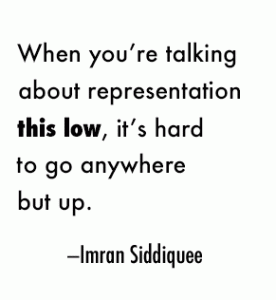 Too many wealthy, white men still run Hollywood, and their decisions still have too much power. As I mentioned earlier, these kinds of movies are very expensive, and so it’s hard for independent or upstart filmmakers to break through or compete.
Too many wealthy, white men still run Hollywood, and their decisions still have too much power. As I mentioned earlier, these kinds of movies are very expensive, and so it’s hard for independent or upstart filmmakers to break through or compete.
That being said, the slight increase in success for white women in blockbuster sci-fi movies, such as Gravity, The Hunger Games, and Divergent, means change is possible. And it’s hard to overstate the importance of the Oscar wins for 12 Years a Slave last year, because while it wasn’t a blockbuster, it is a film that everyone in the industry now knows about and has probably seen. And the whole reason we’re even talking about representation in movies right now is because we know how much seeing different experiences on screen can impact people’s real world thoughts and attitudes. So films like 12 Years a Slave are part of the gradual shifting of consciousness that has to happen in Hollywood to get to a point where studios are consistently greenlighting big-budget films starring people of color.
ML: As budgets for tentpole science fiction and fantasy movies have soared, studios have been more reluctant to take a chance on actors or characters that they perceive as risks. Because people of color and women are also already more likely to consume movies than white people and men, maybe they don’t feel an incentive to change what they are doing because, from their perspective, minorities are perfectly willing to watch films starring white guys. Hollywood is pretty stubborn, especially when it comes to tentpole movies. We are seeing more diversity in television, particularly in children’s television, as well as in online content. The establishment will change when someone influential in Hollywood decides to take the risk and make an effort to diversify their film offerings. The stats in this infographic are focused on profit, not art. For things to change, Hollywood needs to believe that diversity can be profitable.
***
This is not an isolated incident, but a wide reaching societal problem.
Read more Diversity Gap studies on:
The Academy Awards
The Tony Awards
The Emmy Awards
The children’s book industry
The New York Times Top 10 Bestseller List
US politics
Further resources on how to teach content and visual literacy using Lee & Low Books’ infographics series on the Diversity Gap:
Using Infographics In The Classroom To Teach Visual Literacy
CONTACT: For more information or to request permission to reprint, please email hehrlich[at]leeandlow[dot]com
Filed under:
Diversity, Race, and Representation,
Guest Blogger Post,
The Diversity Gap Tagged:
African/African American Interest,
Asian/Asian American,
diversity,
Latino/Hispanic/Mexican,
LGBT,
Middle Eastern,
Multiracial,
Native American,
Race issues,
Science Fiction/Fantasy,
whitewashing 

title: Feral Nights
author: Cynthia Leitich Smith
date: Candlewick; 2013
main character: Yoshi Kitihara
Yoshi is a high school senior being raised by his grandmother in Oklahoma well, until grams catches him with this girl he brought home for the night. Gram has a strict “No Company Allowed” policy that she enforces with a shotgun. Yoshi is given the boot and he decides to head to Texas in search of his sister, Ruby. Oh, they’re a werecat family.
Feral Nights is told in multiple voices. While I’ve had enough of multi voiced books to last me a lifetime, Leitich Smith carries it off quite well. The voices are unique and easy to distinguish.
There’s Clyde, a werepossum with 4 younger siblings. He sees ghosts.
Travis, whom Ruby is suspected of killing. He’s a ghost.
And there’s Aimee, a human who genuinely likes werepeople.
The witty dialog and use of present tense writing keep the story moving at a brisk pace. Leitich Smith smoothly packs in a unique, descriptive backstory as she builds an incredible world of werepeople, vampires, deities and humans. Wereanimals (werecats, wereorcas, werebears, werelions…) are at the core of the story with a werecat accused of killing a werearmadillo. More than that, they’re Ruby and Travis. While everyone has animal characteristics, they each also have fully developed human personalities. That Leitich Smith manages to do this all in 290 pages is amazing. Just as the reader has gotten familiar with the characters and the relationships they’re building, everything flips on its head. Needless to say, this is not a predictable story.
This review is really doing the book little justice because Leitich Smith so flawlessly weaves her tale. It’s like watching anyone who does something well: you don’t want to pick it apart because you just want to enjoy the artistry.
Feral Nights is the first book in the Feral Series. Feral Curse was released this past January and Feral Pride is forthcoming. All books are published by Candlewick. Cynthia Leitich Blogs at Cynsations. She’s the best selling author of the Tantalize series, Jingle Dancer (HarperCollins) and Rain Is Not My Indian Name (HarperCollins) and number other books.
Filed under:
Book Reviews Tagged:
Cynthia Leitich Smith,
native american,
series 







H ouse of Purple Cedar
ouse of Purple Cedar
Author: Tim Tingle
Date: February, 2014; Cinco Puntos
adult crossover
The House of Purple Cedar is set in Skullyville, Oklahoma at the turning of the 20th century. The New Hope Academy for Girls just burned down and a new Indian Agent has just arrived in town. Rose and her brother, Jamey joined Amofo, their grandfather, for a trip into town, a rare treat that would replace their daily chores. This outing actually placed them in the right place at the wrong time. The town marshall appears, alcohol leads to events and Amofo is struck with a board.
House of Purple Cedar unfolds as a story of how those who are disempowered choose to react when they are abused. The process of deciding how to react was a slow, deliberate process for Amofo as it was for Choctaw elders and Rose keenly observes this process. The narrative voice changes and we come to understand power balances throughout the community. We realize that while an individual’s actions define their own relationship, the community as a whole plays a role in allowing things to happen.
There are houses of purple cedar in the story, however, I’m not sure why ‘purple cedar’. I’ve spent some time researching this wood and can’t find anything about it. The more I looked, the more curious I’ve become about its significance.
Tingle manages better than most to weave in and out of time and back and forth between narrative voices. Rose, a young girl throughout most of the story, is the only character who has a narrative voice thus making the book appealing to young readers. Rose lives with her parents and grandparents in a home outside the city. Skullyville is a small community where Choctaw and Nahullos (Whites) all know each other, worship separately, maintain prejudices and come together in unpredictable ways. While Choctaw identity is essential to the story, this isn’t a story about being Choctaw.
‘Hearing’ the community sing “Amazing Grace” will give you goose bumps. Tingle brings faith to life and makes it another character in this story. No doubt, Tingle is a storyteller! He brings together many characters, details and events in this story in a very gentle, purposeful way.
Thank you, Bobby Byrd of Cinco Puntos, for providing me a review copy at ALA Midwinter!
Filed under:
Me Being Me Tagged:
adult crossover,
book review,
native american,
Tim Tingle 








By: Sylvan Dell Publishing,
on 2/27/2014
Blog:
Sylvan Dell Publishing's Blog
(
Login to Add to MyJacketFlap)
JacketFlap tags:
Children's Books,
Storytelling,
folklore,
cherokee,
Native American,
Sylvan Dell,
Sylvan Dell Posts,
Sylvan Dell books,
First Fire,
Add a tag
With the release of our new book, “First Fire,” which is a retelling of a Cherokee folktale, we decided to sit down with storyteller, Lloyd Arneach, to find out more about the culture and the art of storytelling. Arneach is a longtime Native American storyteller that got his start in a rather interesting and unexpected way. He’s keen on Cherokee culture, having  grown up in Cherokee, North Carolina, and learning from his family. Arneach spent about twenty years sharing the culture and history of his people at universities, museums and even Girl Scout meetings. Now he’s been a storyteller now for over twenty years and still has a lot of stories to be told.
grown up in Cherokee, North Carolina, and learning from his family. Arneach spent about twenty years sharing the culture and history of his people at universities, museums and even Girl Scout meetings. Now he’s been a storyteller now for over twenty years and still has a lot of stories to be told.
Me: Can you tell me a little bit about how you first got involved with storytelling? What inspired you?
Lloyd: Well, I really backed into it! My late wife and I were living in Atlanta, and we had a babysitter who was in a Girl Scout troop. And she couldn’t find a book on Indians in the entire county library system. And she said, “wait a minute! I babysit for an Indian, maybe he can help me.” So she called me up and asked if I could help her and I said sure. She told me the requirements, and they were fairly simple and I said, “sure! But I’m going to have to come straight from work, I won’t have time to go home and change. Is that going to be a problem?” She said no, so the next Girl Scout meeting I came straight from work. I went in and sat down and the young girls looked at me and I could hear one of them say, “I don’t know where the Indian is but he’s going to be here pretty soon.” I was working as a computer programmer at that time and I was wearing a three-piece suit, so you don’t see many Indians in three-piece suits. I got up to talk and you could hear their jaws hitting the ground. She started calling other scout leaders who had the same problem in that county, they couldn’t find books on the Indians. I became a resource material as a result. Boy scouts started calling, and then schools started calling, and museums started calling. I was sharing primarily Cherokee culture and history at that time.
In 1985, I got a call from student at Georgia State University and she said she was in a Folklore class. Her assignment was to record stories from original tellers, and I said she would need to go to the reservation in Cherokee to find a storyteller. She said “no, you’d be fine!” So she came and recorded some stories, and I didn’t think anything about it. Then in ‘88 I got a call from Dr. John Burleson at Georgia State and he said “I teach the Folklore class here at Georgia State and our students have been collecting stories. And the stories we have recorded from you I’m going to be putting in a book with these others I have collected, and I’m calling all storytellers to be invited to a book signing. Would you be willing to come?” I said, well let me know. Well, in November of ‘88, we discovered my wife had a terminal brain tumor. It destroyed her motor capabilities and she couldn’t walk, she had very little control of her hands. But her mental capabilities were still there and her ability to communicate had not diminished. My father-in-law, my son, and I brought her home and someone was with her twenty-four hours a day. I was still working at that time, so I would go to work and my father-in-law and son would be taking care of  her during the day and I would come home and I would relieve my father-in-law and he’d go fix supper and come back and relieve me while I ate supper. This is how it went until the spring of ’89. Dr. Burleson called me back and said “we’re going to have a book signing in September would you be willing to come?” And I talked to my wife, Charlotte, and she said “go ahead!” you know, I needed to get out of the house. Well, she passed away in the end of August in ’89 and I was doing everything I could to fill my time. So I went to the book signing and as I was taking a break, a lady came up to me and said “I’m Betty Ann Wylie and I’m a member of the Southern Order of Storytellers. We have a storytime festival in January, would you be willing to come and share your stories?” and I said “YES!” so in January of 1990, I started sharing stories. It was never something I intended to do.
her during the day and I would come home and I would relieve my father-in-law and he’d go fix supper and come back and relieve me while I ate supper. This is how it went until the spring of ’89. Dr. Burleson called me back and said “we’re going to have a book signing in September would you be willing to come?” And I talked to my wife, Charlotte, and she said “go ahead!” you know, I needed to get out of the house. Well, she passed away in the end of August in ’89 and I was doing everything I could to fill my time. So I went to the book signing and as I was taking a break, a lady came up to me and said “I’m Betty Ann Wylie and I’m a member of the Southern Order of Storytellers. We have a storytime festival in January, would you be willing to come and share your stories?” and I said “YES!” so in January of 1990, I started sharing stories. It was never something I intended to do.
So from 1970 to1990, I was just sharing Cherokee culture and history, but in 1990 I started sharing stories and I’ve been doing it ever since. So it was never something I intended to do, I literally backed into it.
It’s something I thoroughly enjoy, I had never really thought about it. I was a very introverted individual. My late wife brought me out of my shell. She taught me that people are interesting, but you have to talk with them to find out these interesting things about them. If you don’t talk, you don’t know. She was a very good people person; she had unbelievable people skills. She taught me to come out and enjoy people, and if she hadn’t done that I would have never agreed to do the first session in front of the girl scouts.
Me: How did you learn the stories? Who taught you?
Lloyd: I had two great uncles who were wonderful storytellers and at our family gatherings, Uncle George would tell a story and Uncle Dave would tell a story. It was like a tennis match! And without realizing it, I was learning the old stories of our people. And then my mother had Tuberculosis for two years and I went to live with my great uncle. My great aunt taught French at the University of Oklahoma, so we went out during the winter to Oklahoma where she teached University. My other aunt, my mom’s sister, was studying languages and lived on the cottage at Aunt Dell and Uncle George’s property. She and Aunt Dell would speak French. Well without realizing it, I was in second grade, I started picking up conversational French. So after the school year ended, we came back to Cherokee for the summer. I was walking through downtown Cherokee, after graduating from the second grade, and this tourist stopped me and said “Hau! You speak-a the English?” and I said “Bonjour! Comment ça va?” He called his wife over, “hey Gertrude! Get over here and listen to this kid speak Indian!” So that’s when I realized how much people really didn’t know about Indians, in second grade. So when I was going out sharing culture, I tried not to dress in the feathers and buck skin, because I realized the young people would think this is what an Indian looks like today. So I wanted to try to avoid that stereotype. Also not many people knew of an Indian who was a computer programmer – they don’t associate those two.
Me: Do you find that stories change over time since they are all learned through word-of-mouth?
Lloyd: The nucleus of the story stays the same, but each person uses different words. Some people might use very flowery descriptions of the “long winding trail to the sharp rock,” somebody else might say “he took the long trail up to the top of the mountain.” But still, the important essence was that he went to the top of the mountain.
Me: Which do you prefer? Do you prefer more flowery descriptions?
Lloyd: Not flowery, but I try and visualize the story as I’m telling it and describe what I see. I’m aware the audience may not be aware if I say “there were snake dens,” but if I say “there were Rattlesnake dens,” suddenly they’re realizing “oh my gosh! This wasn’t just a walk past snakes, but they were dangerous snakes!” and it pulls their attention into the story. I’m trying to keep the audience involved in the story. If I say, “Well, there were some Indian medicine right along the trail, that means nothing. If I say “there was kudzu” which we have learned to use for medicine, they say “oh!” and it’s a totally different approach to the story.
Me: Do you have a personal favorite story to tell?
Lloyd: Yes, Chief Joseph and the Flight of the Nez Perce. A very moving story and for me, I have to have about an hour with the audience. And what I do when I first go into a program, I do a couple of stories and do a very quick read on the audience. And by “read,” I mean that when I tell a story, there may be a point in the story where the audience should react and they may laugh, but instead their response should be an “ohhh yes” and when I get that reaction I realize they don’t understand the story. And so I’ll switch to a different group of stories and they’ll never realize the program has changed in mid-stride. It’s just been garnered over years of sharing with different groups and seeing how they respond. One of the best pieces of advice came from an internationally known storyteller named Carmen Deedy, and she was really my first good mentor when I was coming up. She was very quick, she picked things up very very fast, a very intelligent woman. And we were talking, I was grousing about the programs I had and how I couldn’t get this one guy to pay attention. And she said “Lloyd, if there are a hundred people in the room and one person isn’t paying attention to you, why are you focusing on them? There are ninety-nine people who are hanging on every word, share with them. If the one person comes around, fine, but reward the ninety-nine people for their attention.”
That would save me so much heartache over the years, because it was obvious some people didn’t want to be there. “Storytelling? That’s for kids!” But I’d tell them, if you give me twenty minutes and an open mind, I will change the mind of any adult.
I’m seventy and I only have a few summers left where I can get out and travel on my own without someone attending me or worrying about me. So I’m cutting down a lot of my programs now, because there’s still things I want to do – I’ve still got my bucket list! And that involves traveling.
Me: Is there one thing you’d want younger generations to know about the Cherokee or storytelling?
Lloyd: Stories are meant to be shared. Share them. Everybody has stories. They might not realize it but everybody has stories.
If you’re interested in learning more about Lloyd Arneach, visit his webstie at www.arneach.com
Learn more about our book “First Fire” here: http://www.sylvandellpublishing.com/bookpage.php?id=FirstFire



By:
Jason Low,
on 9/18/2013
Blog:
The Open Book
(
Login to Add to MyJacketFlap)
JacketFlap tags:
Emmy Awards,
Race issues,
Multiracial,
Middle Eastern,
Latino/Hispanic/Mexican,
The Diversity Gap,
History,
diversity,
guest blogger,
Native American,
African/African American Interest,
Add a tag
Publishing diverse children’s books for more than two decades has given us a unique perspective when it comes to diversity. While our mission is to bring more diverse books to children, we hope our efforts as activists keep the wider conversation on race and inequality in the spotlight. Our previous Diversity Gap studies on the Tony Awards and the children’s book industry revealed a disturbing trend in ethnic and gender representation. We decided to focus on the television industry next.

Emmy Awards infographic (click for larger image)
Our Diversity Gap study on the Emmy Awards was the logical choice for objectively looking at the small screen. Since the Emmys will be presented on September 22, 2013, we collected data to see if a diversity gap exists in television. See our infographic above for Emmy related facts like:
- No woman of color has ever won an Emmy Award for Best Actress in a Drama Series
- In the last twenty years, winners in the Best Director of a Comedy Series were 100% white and 95% male
- An African American woman has not been nominated for lead actress in a Comedy Series since The Cosby Show (1986)
We implemented the methodology we have used previously, with the help of the Writer’s Guild of America West, and we were fortunate to have the opportunity to speak with two talented writer/actors. Their combined insights into the mechanism behind making television illuminate why the lack of diversity in casting and writing remains a very real, very complex problem.

Luisa Leschin definitely believes in the richness of diversity. She has enjoyed four very successful careers: ballet dancer, actress, voice-over artist and television script writer. Her writing credits include The George Lopez Show and Everybody Hates Chris. She is currently developing a children‘s sitcom pilot with EOne Entertainment with a theme of healthy living and is writing a pilot about Latino millennials called Homies.
 Kelvin Yu is a Taiwanese-American writer currently working on the Fox animated series Bob’s Burgers. A Los Angeles native, Yu studied theater and communications at UCLA. His acting credits include Milk, Star Trek, Studio 60 On The Sunset Strip, and The Shield. He also has a small white dog named Yuki who used to live in New York. Neither of them are fixed.
Kelvin Yu is a Taiwanese-American writer currently working on the Fox animated series Bob’s Burgers. A Los Angeles native, Yu studied theater and communications at UCLA. His acting credits include Milk, Star Trek, Studio 60 On The Sunset Strip, and The Shield. He also has a small white dog named Yuki who used to live in New York. Neither of them are fixed.
Luisa, what types of roles were you being cast for when you were an actress?
LL: I was lucky enough to be a working actress during the 1980s and early 1990s. I started my career in New York, where I studied with Uta Hagen, a legendary actress and teacher. I speak un-accented English, but judging from my auditions, I soon realized that I better work on my Mexican, Cuban, Guatemalan, Colombian, and Puerto Rican spitfire accents because those were the only roles for which I was being considered. I remember walking onto the set of Hill Street Blues, where I was playing the pregnant girlfriend of a gang member. We had just been arrested. My fellow “actor” introduced himself to me and asked me how many times I had been arrested, because he’d been arrested twice! Toward the end of my on-camera career, I did a “role-count” and discovered that I had played a pregnant woman (in various stages of delivery) no less than six times, hookers, maids, gang-girlfriends, and as I got older, gang-girlfriend’s mothers . . . and not much else.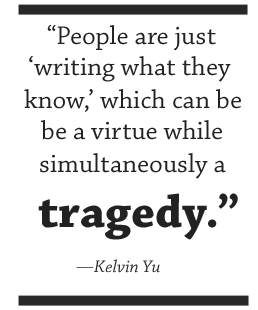
Kelvin, in our initial conversation you said you felt that as an actor you have resigned yourself to always playing second banana—that you would never appear as a main character in a TV show. You attributed this to a standard of beauty. Could you elaborate on this for us?
KY: I may have used the word “resigned” but I think, more accurately, as an Asian American actor you just come to understand the market place as it is. That’s not to say that you don’t hope it could someday change, but you understand that American audiences are not generally even ready for a female lead most of the time, so it is unlikely they will mass-consume a television show or a studio feature with an Asian American carrying the story. That said, this year we’ve seen Mindy Kaling and Ken Jeong take on huge projects that are viewed by millions of people. But these are, of course, the exception rather than the rule.
As I said before, it’s not entirely an issue of race either. I don’t think Dan Devito had any illusions in Romancing the Stone that he was gonna get to kiss Kathleen Turner. The paradigm of the American hero is, in the main, a handsome white dude, say, six feet tall—and that’s just how it is. I truly feel though, at the end of the day, audiences are going to connect with the best storytelling. We’ve seen that movie goers will champion protagonists in every shape, color, or form (even a talking pig!) if the storytelling is honest and resonant. So in some ways, I just challenge Asian American writers, producers, and directors to introduce great stories that feature different types of protagonists. It wouldn’t be fair or realistic to charge other people to tell your stories. People are just “writing what they know,” which can be a virtue while simultaneously a tragedy.
Luisa, you founded the comedy troupe Latins Anonymous. Tell us the goal of Latins Anonymous and how this led to you become a writer.
LL: The resulting frustration of having a demo reel that was a hit parade of stereotypes led me to join forces with three other Latino actors who were in the same boat. We knew that as actors we were powerless to effect change from the stage. We just didn’t have the voice to do it. The real power came from higher up—the writers and producers. So that’s why I embarked on a writing career, to help change how Latino roles were written and perceived, and also just to get more Latino actors in front of the camera. Ironically, this move pretty much killed my acting career because casting directors who came to see our show skewering stereotypes were too embarrassed to offer us those same stereotypical roles.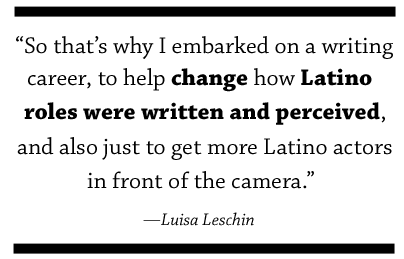
Kelvin, you attended college at UCLA, where the number of Asians make up 49% of the student population. Yet you mentioned that you are the only person of color in a thirteen person writing team. Why doesn’t the density of Asians living and working in Southern California amount to a larger representation of Asians in decision-making roles in TV?
KY: Don’t know. I know for a FACT that Asian Americans love to consume media—movies, television, video games, social media, all of it—so their lack of representation over the past several years is probably a combination of factors including cultural emphasis in different fields, a lack of avenues within the industry, and some level of systemic prejudice (particularly in the past).
However, I do think this is about to change big time. I think in the next few years you will see a flood of Asian content creators. Some of that is simply the rapidly closing cultural gap that social media and the internet are facilitating. Young Asian writers and actors and directors are growing up seeing Ang Lee and Justin Lin and Wong Kar Wai and Zhang Yimou win Oscars and BAFTAs. The world, for better or for worse, is remarkably smaller than it was a decade ago and audiences are more open, even hungry, for unique voices. I also think new media renders many of those past obstacles powerless against the thousands of outlets for Asian American creativity. For instance, even if your stern Korean father wants you to become a doctor, he can’t really stop you anymore from making small movies with your iPhone and cutting them with some app. People can write, shoot, edit, and even distribute content from a $300 laptop. How was an Asian American teenager supposed to do that in 1990? Not to make Asian parents seem like the only barrier, and also not to make them seem all like Kim Jong Eun. I just think we’re about to see an influx of new voices and, thus, new stories. Which is very exciting.
Luisa, during our conversation you mentioned “that there is a system” in place to break into writing for television. Describe for us what that system is and what are some of the hurdles involved with addressing the problem of the diversity gap in TV programs.
LL: We all know the famous quote by William Goldman: “In Hollywood, no one knows anything.” And we also know that many roads lead to Rome. . . . So, having stipulated that, I’m talking about the established network system. If you manage to get in on the ground level as a staff writer or story editor and then move up the ladder to senior story editor, producer, co-producer, and ultimately co-executive producer you will then become a known entity to the networks. At this point the powers that be feel confident that you have experienced firsthand about how TV shows are written and run. The network is willing to listen to show ideas from you, willing to consider ordering a pilot from you, because they know you have put in your time working under showrunners they trust and that you have experience on how things are done. This is the path that most showrunners have taken to rise to the position where a network trusts them to run a multi-million dollar show.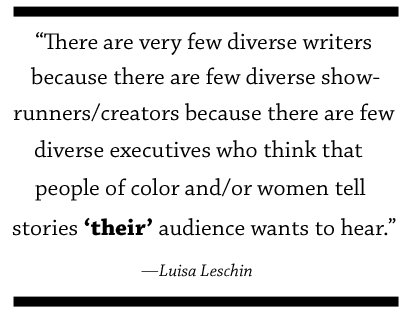
Which brings us to the biggest problem facing us in trying to narrow the diversity gap. There are very few diverse writers because there are few diverse showrunners/creators because there are few diverse executives who think that people of color and/or women tell stories that ”their” audience wants to hear. Certainly there are other ways of breaking into television writing, especially with all the new media platforms, but ultimately there are no shortcuts for putting in the time and learning the workings of television from the bottom up.
Kelvin, what are some of the factors that may keep white writers and producers from taking a chance on casting or writing more characters who are people of color into TV shows?
KY: I honestly think most writers just write what they know. Particularly in TV, which is by definition on a deadline, it’s just not going to be your instinct to pitch a story about a Pakistani family if you have never had any experiences with Pakistani families. Nor do I blame writers and producers for remaining within a personal wheelhouse of stories that reflect their particular vantage point on the world. Every once in a while, you get an Ang Lee or a Coen Brothers—storytellers who find a way to turn something quite foreign to them into something deeply personal. But I think most of us, when given that rare chance to tell a story, want to tell the stories we dreamed of sharing with the world. Our own stories. And that’s okay. That’s not just okay; that’s good. So the issue is, how do we get more eclectic people into the room? How does the face of TV writing start to look more like the face of America?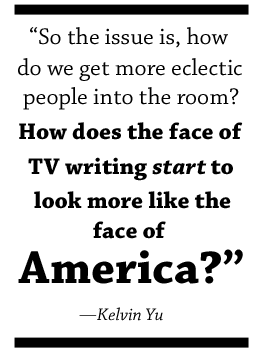
Luisa, you worked on The George Lopez Show, which aired for five seasons. From your description of the system, how did a show like this get made in the first place?
LL: It took a movie star, an established showrunner of multiple hit shows and an exceptional talent. At the time, Sandra Bullock had a development deal at Warner Brothers. Someone told her about stand-up comedian George Lopez and she and showrunner Bruce Helford (Creator of Norm, The Drew Carey Show, and Anger Management) went to see his show. Sandy fell in love with George’s talent and told Warner Brothers this was the show she wanted to develop. It took a lot of pull and star power to get the show on the air.
Everyone always has that one great idea for a pilot. But it’s seldom about the idea. All you have to do is look at most hits on TV. Cosby, a show about a family; Seinfeld, a show about nothing; Friends, six friends sitting on a couch. The salability of a pilot really rides on the team behind it. Who is the talent big enough to carry a show that has broad appeal for middle America? And who will be writing and running the show? This is why the same dozen showrunners get pilot after pilot every season. (Can you say Chuck Lorre? Bill Lawrence?) It’s because they have a track record in the network system and executives know they can deliver a show.
Luisa, you have done considerable work on some successful sitcoms over the years. Are there shows that you have worked on, or actors and actresses, who have been overlooked by the Emmy Awards?
LL: Yes! Every show I have worked on had brilliant actors who should have been at least nominated to receive an Emmy: George Lopez, Constance Marie, Belita Moreno from The George Lopez Show; Terry Cruise, Tichina Arnold, both from Everybody Hates Chris. Too often shows that feature diversity are overlooked by voters of the Academy. I don’t believe it’s any kind of conscious bias. Having been a judge for a few award shows myself, I discovered that I was more favorably inclined to a show if I had already watched the show, if I was familiar with the characters or if I might have already seen the nominated performer or episode. In short, I was already a fan. The sad fact is that most judges in the Academy are not diverse and may not be watching shows that feature diversity and/or diverse characters.
—
One thing worth noting about the 2013 Emmy Awards: Kerry Washington is nominated for best actress in a drama for Scandal. If she wins, she will be the first actress of color to win an Emmy Award for a drama in the sixty-five year history of the award! The fact that she is nominated at all is a testament to Shonda Rhimes’s style of ethnically inclusive casting and writing. Ms. Rhimes is essentially the embodiment of what Luisa Leschin describes as the television system for breaking into writing. Ms. Rhimes worked her way up the ranks, paid her dues, and became a showrunner. Her version of television presents a real world example of what TV shows could look like: ethnically and gender inclusive, entertaining, and . . . successful.
Our Emmy Award study, much like our studies on the Tony Awards and the children’s book industry show that the diversity gap is a widespread, societal problem that we all have a responsibility to fix.
Filed under:
guest blogger,
The Diversity Gap Tagged:
African/African American Interest,
diversity,
Emmy Awards,
History,
Latino/Hispanic/Mexican,
Middle Eastern,
Multiracial,
Native American,
Race issues 


By:
Jason Low,
on 3/13/2013
Blog:
The Open Book
(
Login to Add to MyJacketFlap)
JacketFlap tags:
Middle Eastern,
Asian/Asian American,
Latino/Hispanic/Mexican,
Awards,
Book News,
diversity,
first book,
LGBT,
Native American,
African/African American Interest,
Bellringers,
Race issues,
Multiracial,
Dear Readers,
Add a tag
In a groundbreaking announcement, First Book, a non-profit social enterprise launched the Stories for All Project. The project’s aim is to introduce a significant number of multicultural books into the hands of low-income children. LEE & LOW was chosen as one of two publishers to be a part of this endeavor and receive a $500,000 award.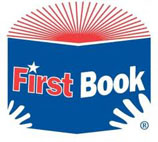
For us the presence of this project further addresses the fact that diverse books are a necessity. Making multicultural books available to low-income families is a step toward addressing the chasm between people who believe these books are important to actually making the books available to the children who need them.
For years I have been involved in conversations with librarians and educators on the subject of how we need more diverse books. However, there is this strange disconnect where people continue to point out the lack of diverse books without doing the most obvious thing, which is supporting the companies that publish these books in the first place. The support is simple. It involves buying the books. It also involves telling people about the books and recommending them to buy the books. The more this happens the more books we can publish.
What First Book has done is monumental in supporting multicultural books. It is a bold statement that I hope is just the beginning. An infusion of this many diverse books increases the chances of a child being able to see a face like his or her own staring back at them from the pages of a book. This moment of recognition for a child will create a profound experience that will be forever associated with the act of reading. This powerful relationship to books is one that they will hopefully cultivate for the rest of their lives.
On behalf of everyone at LEE & LOW I want to thank CEO Kyle Zimmer, Executive Vice President Chandler Arnold, Vice President Erica Perl, along with all the dedicated people working on the Stories for All Project. First Book’s commitment and dedication to literacy and multicultural literature is to be commended. This will be a game changer for many children who will be receiving their very first book ever.
Filed under:
Awards,
Bellringers,
Book News,
Dear Readers Tagged:
African/African American Interest,
Asian/Asian American,
diversity,
first book,
Latino/Hispanic/Mexican,
LGBT,
Middle Eastern,
Multiracial,
Native American,
Race issues 

Oh yeah. Buffalo Bill has set up shop in Paris. Like a persistent ghost . . .
The Wild West show and the dime novel were the origins of the western genre, which in the beginning was all about explaining just what are all these white people doing in this untamed country? After making his name killing buffalo, William Frederick Cody became the star of dime novels and pioneered the Wild West show: a chimera of theater and the circus that is also an ancestor of performance art.
 McNenly’s book is a fascinating account of this business/art form with political consequences. It focuses on the native performers and their transformation from menaces to commercial attraction/myth figures. Faced with the deconstruction of their world, you can’t blame some for preferring show biz to the Office of Indian Affairs’ “civilizing” policies on the reservations.
McNenly’s book is a fascinating account of this business/art form with political consequences. It focuses on the native performers and their transformation from menaces to commercial attraction/myth figures. Faced with the deconstruction of their world, you can’t blame some for preferring show biz to the Office of Indian Affairs’ “civilizing” policies on the reservations.
As Short Boy, put it in 1911: I wouldn’t go back to the reservation for a new rifle and cartridges enough to last me the rest of my life . . . He enjoyed fighting American soldiers “even with blank cartridges.”
In 2004, Kevin “Kave” Dust, who worked at the Euro Disney (with Mickey Mouse) explained: I am protected through the medicine man and my strong tradition. I am still here, still proud, and still alive.
Native Performers in Wild West Show was a rather surreal read for an academic study. It has me rethinking my own Wild West environment, and wondering about futuristic developments.
It also gave me the urge to re-read Mario Vargas Llosa’s The Storyteller. South America’s myths and traditions about native tribes is different than those of the North. No heroic wars romanticized are by popular culture and the entertainment industry. Still, there are parallels to the bizarre world of the Wild West show . . .
 The Storyteller of the title is Saúl Zuratas, called “Mascarita” because of birthmark on his face that, along with his being Jewish, makes him an outsider in Peru. He is driven away from civilization and becomes obsessed with the culture of the Machiguenga Indians: “Do our cars, guns, planes, and Coca-Colas give us the right to exterminate them?” He doesn’t want them made into “zombies and caricatures of men, like those semi-acculturated Indians you see in Lima.”
The Storyteller of the title is Saúl Zuratas, called “Mascarita” because of birthmark on his face that, along with his being Jewish, makes him an outsider in Peru. He is driven away from civilization and becomes obsessed with the culture of the Machiguenga Indians: “Do our cars, guns, planes, and Coca-Colas give us the right to exterminate them?” He doesn’t want them made into “zombies and caricatures of men, like those semi-acculturated Indians you see in Lima.”
Disgusted by acculturation and assimilation, he wishes that Machiguenga could remain isolated, and their culture preserved in a state of purity. Instead of creating a mestizo identity for the modern world, he goes native, becoming a storyteller for the tribe.
But still, civilization is out there, creeping through the jungle . . .
Meanwhile, in Arizona, I see postmodern Americanos looking for the same kind of purity and spirituality that’s missing in their lives. They often find themselves in the hands of snake oil salesmen. Sedona is an inside-out Wild West show, with high-priced psychics instead of simulated Indian attacks.
Eventually, the entire world could be a Wild West show, but who will be the natives?
If you look at the rodeo coverage in the Navajo Times, these days, a lot of the cowboys are Indians.
The story of the Dakota War of 1862 — a six-week clash between Dakota warriors and white soldiers on the Northwestern frontier that left hundreds of settlers dead and culminated in the execution of 38 Native Americans on the day after Christmas, the largest mass execution in United States history — is grim. Its troubling [...]
What a powerful collection of short stories! Alexie really stretches his wings and explores fascinating new territories, while at the same time revamping his old works by placing them in new contexts. I was completely blown away by Mr. Alexie, as usual. Books mentioned in this post $27.00 New Hardcover add to wish list Blasphemy: New [...]
The Turkey Girl
To a young girl who tends turkeys for a living, an opportunity to go to The Dance of the Scared Bird seems but a distant dream...another retelling of the Cinderella tale...
If you liked this, try:
The Egyptian Cinderella
Yeh-Shen
The Rough-Face Girl
The Golden Sandal
Smoky Mountain Rose
Buffalo Bird Girl
This fascinating picture book biography tells the childhood story of Buffalo Bird Woman, a Hidatsa Indian born around 1839. Through her true story, readers will learn what it was like to be part of this Native American community that lived along the Missouri River in the Dakotas, a society that depended more on agriculture for food and survival than on hunting...
If you liked this, try:
Unspoken
The Herd Boy
The Star People
Grandfather Buffalo
Gift Horse
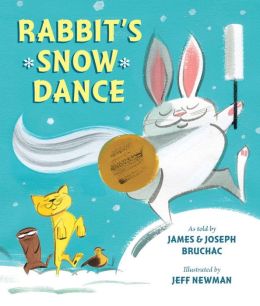
Rabbit's Snow Dance
Rabbit loves the winter. He knows a dance, using a traditional Iroquois drum and song, to make it snow--even in springtime! The other animals of the forest don't want early snow, but Rabbit doesn't listen to them. Instead, he sings and dances until more and more snow falls. But how much snow is too much, and will Rabbit know when to stop? A hilarious fable!
If you liked this, try:
Bear has a Story to Tell
Goldilocks and the Three Dinosaurs
Chloe
Snowmen at Work
Brave Squish Rabbit
I had to get up and turn the heat up before starting this post. It is definitely getting colder outside. Yesterday was Cookies and Cocktails and I spent the day baking cookies with my sister. No doubt it was a long, long day but it’s a tradition we do not want to give up any time soon. I’ve boxes wrapped and ready to ship off to family and friends who I hope will enjoy eating them as much as we did baking them! I’ve also contacted several people for my annual Cookie Traditions posts and hopefully those will begin rolling in soon.
Zetta Elliott has beem working on completing her annual list of MG and YA books by African American authors.
In doing this work, Zetta urged me to collate my list according to ethnicity so that we can see how many books were compiled by Native Americans, Asian Americans and Latino/as as well. I cleaned up my list removing nonfiction titles and a few that I decided are too young for MG readers and categorized the books I found. I added the titles I didn’t have that Zetta found and some from Debbie Reese as well. I am sure there are books written by authors of color and published by traditional publishers that I have missed, and hope that you will mention them in the comments.
Does this matter? Of course, it does. I’ve been saying for months the numbers and dropping and I’d like to figure out why, particularly since the overall number of children’s books is up this year. This year we say Neesha Meminger, L. Divine and B.A. Binns all self publish. Don’t you think its time for another YA from Cindy Pon? Alex Sanchez? Medeia Shariff? Dia Reeves?
“In the Margins Committee
What is it? A group of librarians creating a committee to seek out and highlight books: preschool through adult fiction and non-fiction titles of high-interest appeal to boys or girls, ages 9-18 who may fit into one or all of the following categories:
multicultural (primarily African American and Latino) from a street culture in restrictive custody reluctant readers What does it do? The committee will select and review the best books of the year, specifically for the population listed above. Titles of interest will be unusual, possibly unreviewed, have multicultural characters, dealing with difficult situations including (but not limited to) street life, marginalized populations, crime, justice, war, violence, abuse, addiction, etc. The first year we will also review a few older titles that may not have been reviewed previously but which are deserving of attention.
Committee membership and requirements: research and nominate titles that are self published, independently and published by small presses provide written review of books, and read for special content for detention facilities read all nominated titles work with or do outreach to teens in custody and/or from street culture. get feedback from at least 3-10 teens on each title actively participate in email discussions meet 1-4 times a year via video conferencing and/or in person opportunity to blog in column about your and your youth’s experiences with a certain title or author Don’t delay – Apply today!”
No doubt incarcerated teens need books which will interest them as these teens often have incredibly poor reading skills. And I think the intent of this committee is to review books for those who work with incarcerated teens. If I read correctly, these reviews will appear in SLJ as the chair of the In the Margins Committee now has a blog on SLJ’s site. Will this blog be balanced with one that gives a wider representation to African American and Latino (and Native American and Asian American) literature? What effort will SLJ make to educate readers about the vast contrtibutions writers of color make to teen literature and the even broader reading preferences of teens of color?
This is what the CCBC reported for 2011: We received approximately 3,400 books at the CCBC in 2011. Of those,
• 123 books had significant African or African American content
• 79 books were by Black authors and/or illustrators
• 28 books had American Indian themes, topics, or characters
• 12 books were by American Indian authors and/or illustrators
• 91 books had significant Asian/Pacific or Asian/Pacific American content
• 76 books were by authors and/or illustrators of Asian/Pacific heritage
• 58 books had significant Latino content
• 52 books were by Latino authors and/or illustrators
This is what I found so far for 2012.
MULTI-ETHNIC
1. Diverse Energies edited by Tobias Buchnell and Joe Monti; Tu Books, November
NATIVE AMERICAN
1. Chronal Engine by Greg Leitich Smith, illus. by Blake Henry;Clarion Books, Feb. 22
2. Outcasts of River Falls: sequel to Belle of Batoche by Jaqueline Guest; Regina Coteau Books for Kids, 1 Apr
3. Diabolical by Cynthia Leitich Smith; Candlewick Press; 14 Feb
ASIAN AMERICAN
1. The friendship matchmater by Randa Abdel-Fattah; Frances Lincoln, 6 Sept
2. What’s Left of Me: The Hybrid Chronicles, Book One by Kat Zhang; Harper Collins, 18 September MG
3. Adaptation by Malinda Lo; Litte, Brown Books for Young Readers 18 Sept
4. Ash Mistry and the savage fortress by Sadwat Chadda; Harper Collins, October
5. The girl who lept through time by Yasutaka Tsutsui and David Karashima; Alma Books 1 Sept
6. Bobby the Brave (Sometimes) by Lisa Yee and Dan Santant; Scholastic, 1 Aug
7. A beautiful lie by Irfan Master; Albert Whitman & Company, 1 August
8. The choke artist: confessions of a chronic underachiever by David Yoo; Grand Central, 19 June
9. Reincarnation (Legend of Snow Wolf series) by Fred Lit Yu; China Books, 1 June
10. Article 5 by Kristen Simmons; Tor, 2012
11. Dumpling Days by Grace Lin; Little Brown Books for Young Readers; 2 Jan
12. Tina’s mouth: an existential comic diary by Keshni Kashyap and Mari Araki; Houghton Mifflin Harcourt, 3 January
13. The whole story of half a girl by Veera Hirandandani; Delacorte Books for Young Readers; 2012
14. Lovetorn by Kavita Daswani; HarperTeen; 17 Jan
15. Fair Coin by E. C. Myers; Pyr, 27 March
16. Another Jekyl another Hyde by Daniel and Dina Nayeri; 27 March, Candlewick
17. The Hunt by Andrew Fukuda; St Martin’s Griffin, Apr. 19
18. The mapmaker and the Ghost by Sarvenaz Tash; Walker Book Childrens, 24 April
LATINO/A
1. A Thunderous Whisper by Christina Diaz Gonzalez; Knopf Books for Young Readers 9 October
2. Summer of the Mariposas by Guadelupe Garcia McCall; Tu Books, October
3. BorderTown #4: No Second Chances by Malin Alegria; Scholastic Nov.
4. The revolution of Evelyn Serrano by Sonia Manzano; Scholastic, 1 Sept
5. Con carino/Love Amalia by Alma Flor Ada; Atheneum Books for Young Readers; 10 July
6. Choke by Diana Lopez; Point; 12 July
7. Border Town #2: Quince Clash by Malin Alegria; Scholastic, 1 July
8. Bordertown #1 Crossing the line by Malin Alegria; Scholastic, May MG
9. Body Slammed! by Ray Villareal; Pinata Books, 30 Apr
10. Border Town#1: Crossing the line by Malin Alegria; Scholastic 1 May
11. Prom dates to die for by Kelly Parra; Buzz Books; 1 May
12. Irises by Francisco X. Stork; Authur A. Levine; Jan 2012
13. Facts of life: stories by Gary Soto; Graphia, January
14. The glass collector by Anna Perera; Albert Whitman and Co. 1 Feb
15. Aristotle and Dante discover the secrets of the universe by Benjamin Alire Saenz; Simon and Schuster Books for Young Readers, 21 Feb
16. The girl who could silence the wind by Meg Medina; Candlewick, 13 March
17. The Temptation: A Kindred Novel by Alisa Valdes; HarperTeen, Apr. 4
AFRICAN AMERICAN
1. Hollywood High by Ni Ni Simone and Amir Abrams; Kensington 12 Sept
2. No Boyz Allowed by Ni-Ni Simone; Dafina Books, 31 July
3. Hollywood High by Ni-Ni Simone and Amir Abrams, Dafina Books, 25 Sept
4. Pinned by Sharon Flake; Scholastic, 1 October MG
5. Time to Shine by Nikki Carter; Dafina Books, 30 Oct
6. Crazy Love by Amir Abrams; Dafina Books, 27 Nov
7. Dork Diaries 5: Tales from a not so smart miss know it all by Rachel Renee Russell; Aladdin, October
8. Fading Amber: The cambion chronicles #3 by Jaime Reed; K’Teen Dafina 26 December
9. Kiki doin’ it (Juicy Central) Saddleback, 1 Sept
10. Marnyke: the fake date (Juicy Central); Saddleback
11. Tia Diva, (Juicy Central) Saddleback Sept
12. Sherise Stalked,(Juicy Central) Saddleback, Sept.
13. Nishell Tempted by Stephanie Perry Moore (Juicy Central); Saddleback, 1 Sept
14. Settle down/be real Cheer Drama/Baller Swag; Lockwood High Series by Stephanie Perry Moore; Saddleback
15. The diary of B. B. Bright possible princess by Alice Randall, Caroline Randall Williams and Shadra Strickland (illustrator); Turner Publishing 4 Sept
16. Charly’s Epic Fiasco by Kelli London, Dafina Books, 28 Aug
17. A Certain October by Angela Johnson; Simon and Schuster; August
18. Denim diaries 6 Lying to live by Darrian Lee; Urban Books, 28 August
19. Fire in the Streets by Kekla Magoon; Aladdin, August
20. The Cruisers 3: A star is born by Walter Dean Myers; Scholastic 1 Aug
21. Dork diaries 4: Tales from a not so graceful ice princess by Rachel Renee Russell; Aladdin, June
22. Back to me by Earl Sewll; Kimani Tru 1 July
23. Always upbeat Cheer Drama (Lockwood High Series)by Stephanie Perry Moore; Saddleback, 1 June
24. Keep jumping/no hating Cheer Drama (Lockwood High Series) by Stephanie Perry Moore; Saddleback 1 June
25. Settle down/be real Cheer Drama (Lockwood High Series)by Stephanie Perry Moore; Saddleback 1 June
26. Yell out/Do you Cheer Drama (Lockwood High Series) by Stephanie Perry Moore; Saddleback 1 June
27. Back to me by Earl Sewell; Kimani Tru; 19 June
28. Lone bean by Chudney Ross; Amistad, June
29. Download Drama by Celeste O. Norfleet; Kimani Tru, May 20
30. 37 Things I Love (In No Particular Order) by Kekla Magoon; Henry Holt, May 3
31. Happy families by Tanita Davis; Knopf Books for Young Readers, 8 May
32. Burning Emerald: The Cambion Chronicles #2 by Jaime Reed; K-Teen/Dafina; May
33. Creeping with the enemy (Langdon Prep)by Kimberyly Reid; Dafina, 24 April
34. Black Boy White School by Brian F. Walker; HarperTeen 3 Jan
35. The mighty Miss Malone by Christopher Paul Curtis; Wendy A. Lamb Books, January MG
36. The Book of Wonders by Jasmine Richards; HarperCollins, 17 Jan
37. Best shot in the west: the adventures of Nat Love by Patricia C. McKissack, Frederick L. McKissack and Randy Duburke; Chronicle Books, 18 January GRAPHIC NOVEL
38. Mesmerize by Artist Arthur; Kimani Tru, January
39. The clone codes #3: the visitors by Patricia C. McKissack, Fredrick McKissack and Pat McKissack; Scholastic, 1 February
40. Beneath a meth moon by Jacqueline Woodson; Nancy Paulsen Books, February
41. No crystal stair by Vaunda Michaux Nelson; Carolrhoda Press, February
42. DJ Rising by Love Maia; Little, Brown Books for Young Readers; 6 Feb
43. Power Hitter by M. C. Higgins; Darby Creek Pub, March
44. Boyfriend season: Cali boys by Kelli London; K’Teen, 27 March
45. Creeping with the enemy (Langdon Prep)by Kimberyly Reid; Dafina, 24 April
46. All the right stuff by Walter Dean Myers; Amistad, 24 April
47. The Chaos by Nalo Hopkinson; Margaret K. McElderry Books , 17 April
48. On the flip side: A fab life novel #4 by Nikki Carter; KTeen Dafina; 28 February
49. Ship of souls by Zetta Elliott; AmazonEncore, 28 Feb
50. Bad boy by Dream Jordan; St. Martin Griffin, 28 Feb
51. The Agency 3: Traitor in the Tunnel by Y. S. Lee; Candelwick, 28 Feb
What’s missing??
Filed under:
Sunday Reads Tagged:
african american,
asian american,
latino/a,
native american,
teen books 2012 

Roger Gaetani is an editor, writer, and educator who lives in Bloomington, Indiana. He serves as the vice president for World Wisdom, an independent publishing company focused on religious and philosophical texts. With Jean-Louis Michon, he edited the World Wisdom anthology on Sufism, Sufism: Love and Wisdom. He directed and produced the DVD compilation of [...]
In this post, our publicity intern Gina Chung offers some thoughts on reframing the Columbus Day holiday:
Have you ever stopped to think about the implications of celebrating Columbus Day? While most of us probably grew up associating the holiday with classroom rhymes and pneumatic devices (“In 1492, Columbus sailed the ocean blue,” etc.), days off from school, or sales at the mall, it’s important to remember what really happened in October of 1492. Columbus Day occupies a dubious spot in our nation’s calendar, ostensibly commemorating both the “discovery” of the Americas by Christopher Columbus and the subsequent destruction and enslavement of countless indigenous people.
Check out this video created by Nu Heightz Cinema filmmakers Carlos Germosen and Crystal Whelan in 2009. In order to garner support for a movement to “reconsider Columbus Day,” Germosen and Whelan collaborated with indigenous organizations and community activists, giving voice to the horrific and painful stories behind the mythology of the holiday.

In fact, there’s been a push to eliminate Columbus Day altogether and replace it with a federal holiday in honor of Native Americans. As this petition mentions, several states, such as Alaska, no longer recognize Columbus Day, or have replaced it with a day honoring indigenous people.
For example, since 1990, South Dakota has celebrated the second Monday of every October as Native American Day. In California, Berkeley replaced Columbus Day with Indigenous People’s Day in 1992, and in 1998, legislation calling for Native American Day to be celebrated as an official California state holiday on the fourth Friday of every September was also passed. Hawaii also celebrates Discoverers’ Day instead of Columbus Day in order to recognize the Polynesian discovery of the Hawaiian Islands. Many tribal governments have also reclaimed the day as Native American Day, or, like the Navajo Nation, have replaced it with a holiday honoring their own tribe.
Here are two books we found that, like the alternatives listed above, aim to dispel the myths around Columbus Day:
A Coyote Columbus Story, written by Thomas King, a Canadian novelist and broadcaster of Cherokee and Greek descent, and illustrated by Kent 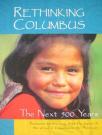 Monkman, a Canadian multimedia artist of Cree ancestry. It tells the story using the figure of Coyote, a traditional trickster character who, in King’s retelling, is a girl who loves to play ball!
Monkman, a Canadian multimedia artist of Cree ancestry. It tells the story using the figure of Coyote, a traditional trickster character who, in King’s retelling, is a girl who loves to play ball!
Rethinking Columbus: The Next 500 Years, edited by Bill Bigelow & Bob Peterson. This collection of essays, articles, poems, teaching ideas, and primary source materials helps educators teach students how to think critically and creatively about the consequences of the arrival of Europeans on the North American continent.
What are some other ways you can think of to observe Columbus Day? Do you have any favorite books or resources that tell the story of Columbus from a Native American perspective? Let us know in the comments below!
Filed under:
Holidays Tagged:
Book Lists,
Columbus Day,
History,
Native American,
Race issues 


By:
Hannah,
on 9/21/2012
Blog:
The Open Book
(
Login to Add to MyJacketFlap)
JacketFlap tags:
native imagery,
diversity,
good news,
Native American,
racialicious,
whitewashing,
Musings & Ponderings,
Diversity Links,
Race issues,
Add a tag
A lot of the time, discussions about diversity, racial equality, and pop culture can be disheartening. A quick look at Racebending or Racialicious is a good reminder of how far we still have to go when it comes to respecting all cultures, especially in the media. But sometimes, good things happen. People and companies take steps forward. And when that happens, we should talk about it. It’s nice to be able to talk about what people are doing right instead of what they’ve done wrong.
With that in mind, I wanted to share this nice story from the Native Appropriations blog. To make a long story short, the company Paul Frank held a “Dream Catchin’ Pow Wow” party in Los Angeles a few weeks ago for Fashion’s Night Out, with a “Neon-Native American Pow Wow theme” complete with plastic tomahawks, feather headdresses, and a drink called the “Rain Dance Refresher.” On her blog, Adrienne wrote up a post about why the party was so offensive to Native Americans and several others wrote, tweeted, posted, or spoke about it as well.
This story could have had the same sad ending many others have: a half-hearted corporate apology but no real change. Instead, Adrienne got a phone call with the president of Paul Frank Industries, Elie Dekel, so they could discuss what went wrong and how to do better in the future. The company outlined several steps they would be taking to right the wrong, including removing Native-inspired designs from their digital/online imprint, working with a Native artist to make new designs, and collaborating with Adrienne and Beyond Buckskin blogger Jessica Metcalfe on a panel about the use of Native imagery in the fashion industry. You can see more about Paul Frank’s plans here.
It’s really nice to see a conversation about the appropriation of Native culture have such a positive outcome. Congratulations to Adrienne, and kudos to Paul Frank for stepping up, apologizing, and earnestly looking for a way to do better.
In other positive news, check out this handsome guy who was cast as Magnus in the upcoming Mortal Instruments movie based on the YA novel by Cassandra Clare:

In this Tumblr post, Clare describes why she was adamant that Magnus be cast as Asian. So many characters of color have been whitewashed in the book-to-movie transition; I’m glad to see that Magnus isn’t one of them.
Happy Friday!
Filed under:
Diversity Links,
Musings & Ponderings Tagged:
diversity,
good news,
Native American,
native imagery,
Race issues,
racialicious,
whitewashing 

Today is International Day of the World’s Indigenous Peoples! According to the United Nations, the theme this year is “Indigenous Media, Empowering Indigenous Voices.” It’s nice to see indigenous groups being recognized not as ancient civilizations or oppressed minorities, but as powerful, modern communities actively working to shape their futures. To that end, I came across this video from the BBC and thought it was pretty cool:
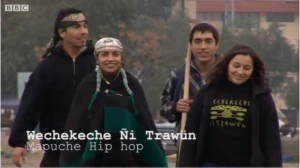
Mapuche Rap – click through to view
What a way to preserve language!
Filed under:
Musings & Ponderings Tagged:
indigenous culture,
Latino/Hispanic/Mexican,
Native American,
Power of Words,
videos 

It’s Olympics time! Have you all been glued to your televisions and various electronic devices for the last 5 days? Or, conversely, have you been dodging your televisions and electronic devices, trying to avoid spoilers?
Either way, the Olympics are one of my favorite things. And while it’s tons of fun rooting for all the current big names (Michael Phelps! Kerri Walsh! Gabby Douglas!) it’s also worth spending a few minutes remembering some great Olympic athletes from the past who paved the way. Here are three to start with:
 1. Sammy Lee (Sixteen Years in Sixteen Seconds): Diver Sammy Lee was born on August 1, 1920 in Fresno, California. Growing up, Sammy was barred from the public pool six out of seven days of the week because he was not white; despite that, Lee became a world-class diver and at the 1948 Olympic Games in London, became the first Asian American to win a gold medal. There’s a great picture of Sammy Lee, now 91, in this now-and-then piece on athletes from the last London Olympics.
1. Sammy Lee (Sixteen Years in Sixteen Seconds): Diver Sammy Lee was born on August 1, 1920 in Fresno, California. Growing up, Sammy was barred from the public pool six out of seven days of the week because he was not white; despite that, Lee became a world-class diver and at the 1948 Olympic Games in London, became the first Asian American to win a gold medal. There’s a great picture of Sammy Lee, now 91, in this now-and-then piece on athletes from the last London Olympics.
 2. Jim Thorpe (Jim Thorpe’s Bright Path): Jim Thorpe is often described as one of the greatest athletes of the twentieth century. He was born in 1887 to a Pottowatomie mother and Sac/Fox father, and was sent to an Indian boarding school when he was very young. He eventually began playing football and running track under the eye of the famous coach Pop Warner at Carlisle Indian School, and in 1912 won gold medals in the Pentathlon and Decathlon at the summer Olympics in Stockholm, Sweden.
2. Jim Thorpe (Jim Thorpe’s Bright Path): Jim Thorpe is often described as one of the greatest athletes of the twentieth century. He was born in 1887 to a Pottowatomie mother and Sac/Fox father, and was sent to an Indian boarding school when he was very young. He eventually began playing football and running track under the eye of the famous coach Pop Warner at Carlisle Indian School, and in 1912 won gold medals in the Pentathlon and Decathlon at the summer Olympics in Stockholm, Sweden.
 3. Duke Kahanamoku (Surfer of the Century): Born in Hawaii, Duke Kahanamoku started off as a surfer and learned how to swim in the warm waters of the Pacific ocean. While swimming in the ocean one day, he was discovered by an attorney named Bill Rawlins who thought he could make Duke a star. Rawlins coached Duke all the way to the 1912 Olympics in Sweden. Duke later competed in the 1920 Olympics in Antwerp, Belgium and 1924 Olympics in Paris, France. In all, he won three gold medals, two silver medals, and one bronze, and held the record as the fastest swimmer in the world for twelve years.
3. Duke Kahanamoku (Surfer of the Century): Born in Hawaii, Duke Kahanamoku started off as a surfer and learned how to swim in the warm waters of the Pacific ocean. While swimming in the ocean one day, he was discovered by an attorney named Bill Rawlins who thought he could make Duke a star. Rawlins coached Duke all the way to the 1912 Olympics in Sweden. Duke later competed in the 1920 Olympics in Antwerp, Belgium and 1924 Olympics in Paris, France. In all, he won three gold medals, two silver medals, and one bronze, and held the record as the fastest swimmer in the world for twelve years.
It’s heartening to see so many countries this year bringing female athletes as part of their delegations for the first time – here’s hoping that decades from now there will be a whole new set of athletes we can celebrate who have broken records inside and outside the stadium!
Filed under:
Summer Tagged:
Add a Comment
| | Title: Crazy Horse’s Vision Author: Joseph Bruchac & S D Nelson Publisher: Lee and Low |
May Contain Spoilers
From Amazon:
| Joseph Bruchac tells the compelling story of how a young boy named Curly seeks a vision in the hope of saving his people – and grows into the brave and fierce warrior Crazy Horse. Sioux artist S. D. Nelson’s paintings, in the traditional ledger style of the Plains Indians, evokes the drama and the tragedy of this important American figure. |
Review:
My fascination with the lives of Native Americans continues. I haven’t read many picture books about Plains Indians, so discovering new reading material at the library has been fun. Crazy Horse’s Vision is my favorite to date. It doesn’t cover much of the conflict between white settlers and the Lakota, instead focusing on Crazy Horse’s childhood. The tone is more upbeat than my previous forays into the lives of famous Native Americans, and the paintings are breathtaking. I love S D Nelson’s use of color; these illustrations are big and bold, the vivid hues jumping off the pages and demanding more than a second glance.
Introducing readers to Crazy Horse, the book follows the carefree days of his youth. Though lacking in stature, he was a charismatic child with a thirst for adventure. Exploring one end of the Lakota territory to the other, where he led, the other boys followed. From his first buffalo hunt to the taming of his pinto horse, bright visuals accompany his childhood triumphs. When trouble brews between his people and the white settlers, Crazy Horse is desperate to help protect his band. Striking out on his own, he seeks a vision to give him the wisdom to help the Lakota during the troubled times that are fast approaching.
Gorgeous illustrations document Crazy Horse and his childhood vision quest. I found this an interesting look at one of the fiercest Lakota warriors. Remembered for his prowess in battle, Crazy Horse was also kind and generous, as well as a man of few words. The prose is interesting and highly readable, but the bold, vivid illustrations are what held my attention and kept me flipping through this book time and again. The paintings are beautiful and made this a delight to read.
Grade: B+
Review copy obtained from my local library
 Subscribe in a reader
Subscribe in a reader
| Title: Black Elk’s Vision: A Lakota Story Author: S D Nelson Publisher: Abrams |
May Contain Spoilers
From Amazon:
| Told from the Native American point of view, Black Elk’s Vision provides a unique perspective on American history. From recounting the visions Black Elk had as a young boy, to his involvement in the battles of Little Big Horn and Wounded Knee, as well as his journeys to New York City and Europe with Buffalo Bill’s Wild West Show, this biographical account of Black Elk—an Oglala-Lakota medicine man (1863–1950)—follows him from childhood through adulthood. S. D. Nelson tells the story of Black Elk through the medicine man’s voice, bringing to life what it was like to be Native American in the mid-to-late nineteenth century and early twentieth century. The Native people found their land overrun by the Wha-shi-choos, or White Man, the buffalo slaughtered for sport and to purposely eliminate their main food source, and their people gathered onto reservations. Through it all, Black Elk clung to his childhood visions that planted the seeds to help his people—and all people—understand their place in the circle of life. The book includes archival images, a timeline, a bibliography, an index, and Nelson’s signature art. |
Review:
I read two books recently about young children victimized by war, and they both broke my heart. In Black Elk’s Vision, a picture book based on Black Elk Speaks by John Neihardt, warfare destroys not only Black Elk’s home, but also his people’s entire way of life. From the cover to the last page, this colorful book is striking and thought provoking. It doesn’t pull any punches, either. From Little Big Horn to the massacre at Wounded Knee, Black Elk’s story is compelling and unforgettable. From the vast plains, hunting buffalo, to the hardship of a walled reservation, his words remain steady and engrossing. I am not sure that I would be as forgiving as Black Elk, Great Vision or not. Manifest Destiny is such an ugly chapter in the history of this country, and I find it painful to read many accounts of settlers as they steamrolled over everything in their path to conquering the West.
There are several parts of this book that I found disturbing, and I am sure that I will find them hard to forget. Before the white settlers flooded like a tsunami over the Great Plains, there were an estimated 30 million bison. Thirty million. By 1889, there were about a thousand. The numbers are mind-numbing. Worse, diseases brought by Europeans wiped out hundreds of thousands of Native Americans. And that was before the settlers began to intentionally drive them off of their ancestral homelands. Thinking about the massive loss of life is nauseating. Thinking about a twelve year old boy forced to defend his life, as well as the lives of his family, is also upsetting. Thinking about having everything you owned, every belief and physical possession, even your way of life, torn away also merits deep contemplation. I would not have survived nearly as well, or lived nearly as gracefully, as Black Elk.
I found Black Elk’s Vision a compelling read. Interspersing colorful acrylics with vintage photos of the events described in Black Elk’s narrative, I found t

By:
Jason Low,
on 6/1/2012
Blog:
The Open Book
(
Login to Add to MyJacketFlap)
JacketFlap tags:
diversity,
politics,
sexism,
LGBT,
Educators,
society,
Native American,
African/African American Interest,
Musings & Ponderings,
Race issues,
Multiracial,
Dear Readers,
Asian/Asian American,
Latino/Hispanic/Mexican,
human-rights,
Add a tag
Throughout the history of the United States, equality for all people has been fought for and won time and time again. Thomas Jefferson wrote in the Declaration of  Independence ”that all men are created equal,” and over time equal rights have been gradually extended to different groups of people. However, equality has never been achieved without heated debate, despite our country’s founding principle that all people are created equal in the first place.
Independence ”that all men are created equal,” and over time equal rights have been gradually extended to different groups of people. However, equality has never been achieved without heated debate, despite our country’s founding principle that all people are created equal in the first place.
The language used to seek equality has remained familiar over time. Posters demanding equal rights (pictured) contain messages we have all seen or heard. One of my theories is that since the human life span is finite, the message of equality has to be relearned by each generation as it comes to realize that more work needs to be done.
If humans lived longer, would full equality across racial and gender lines have been acquired by now? Ask yourself: Would women suffragists from the 1920s, who so 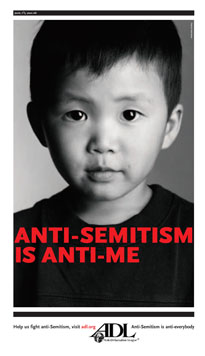 vehemently demanded the right to vote, think it was fine for African Americans to be denied this same right? It depends. My theory also includes the caveat that empathy for others does not always translate into citizens banding together for the greater good. Then again, the social evolution of the United States is progressing. This progression is the reason the language and message of equality remains relevant.
vehemently demanded the right to vote, think it was fine for African Americans to be denied this same right? It depends. My theory also includes the caveat that empathy for others does not always translate into citizens banding together for the greater good. Then again, the social evolution of the United States is progressing. This progression is the reason the language and message of equality remains relevant.
Equality is a shared goal that not everyone enjoys. Racial intolerance for one group is no different than bigotry for another. Denying equality for a particular group plays into the kind of discriminatory trap that makes no sense if one applies the very same principles of equality indiscriminately. All people are created equal, period.
The Declaration of Independence was written with the hope of possibility. Think about it—the signers of this document were declaring a new and independent country! 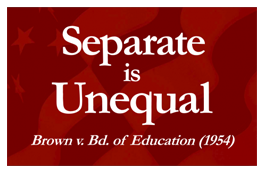 Jefferson’s words made a statement about human rights that became the foundation for a country unlike any other in the world. The signers never anticipated that their vision would eventually embrace so many different kinds of people, but that is the beauty of it. The Declaration was groundbreaking because it provided a foundation of principles and moral standards that have endured to modern times and that accommodate human evolution and its capacity for acceptance.
Jefferson’s words made a statement about human rights that became the foundation for a country unlike any other in the world. The signers never anticipated that their vision would eventually embrace so many different kinds of people, but that is the beauty of it. The Declaration was groundbreaking because it provided a foundation of principles and moral standards that have endured to modern times and that accommodate human evolution and its capacity for acceptance.
Stepping back and viewing all these posters as a whole, one could come to two conclusions. First: the human race does not learn from history. Second: humans 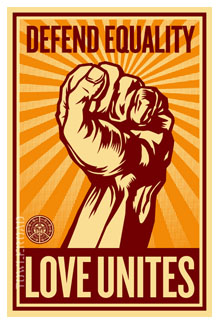 repeat the same mistakes over and over. However, I believe that the preservation and repurposing of the messages of protest in all their different forms are evidence that we do learn from history, and that we apply these tactics when the moment calls for them.
repeat the same mistakes over and over. However, I believe that the preservation and repurposing of the messages of protest in all their different forms are evidence that we do learn from history, and that we apply these tactics when the moment calls for them.
Similar to my previous posts on Race-Based Comedy and Race in Advertising, this post is a small glimpse into a bigger topic that welcomes further discussion. These subjects would be commonplace in a college syllabus, but is there any reason why we shouldn’t introduce dialogue about such issues into our daily lives? At the dinner table, instead of asking your kids how their day was at school and receiving a one-word answer, try bringing
 Carolyn Meyer is the author of many books, most of them delving into the lives of strong young women. Her first historical, Where the Broken Heart Still Beats, is being re-released next week. Since it features one of my favorite historical figures, Cynthia Ann Parker, I was dying to ask Carolyn some questions about this book. She graciously agreed to stop by the virtual offices for a chat.
Carolyn Meyer is the author of many books, most of them delving into the lives of strong young women. Her first historical, Where the Broken Heart Still Beats, is being re-released next week. Since it features one of my favorite historical figures, Cynthia Ann Parker, I was dying to ask Carolyn some questions about this book. She graciously agreed to stop by the virtual offices for a chat.
[Manga Maniac Café] Can you tell us about Where the Broken Heart Still Beats?
[Carolyn Meyer] I discovered this story when I moved to Texas in 1990 and began to make the long drive across the Texas Panhandle. One day I stopped in a Dairy Queen in the little town of Quanah and picked up a brochure on the local history. Quanah was the name of a Comanche chief whose mother was a white woman named Cynthia Ann Parker, kidnapped from her family at the age of 9. She grew up with the Comanches, learned their language and customs, married and had 3 children. When her youngest was an infant, Texas Rangers seized her and the baby girl and took them back to civilization. Cynthia Ann had been kidnapped a second time!
[Manga Maniac Café] Why did you decide to write about Cynthia Ann Parker’s life?
[Carolyn Meyer] Captivity stories were common in the 19th century, but Cynthia Ann was kidnapped TWICE! Her story is well known in Texas, but I couldn’t find any books that told the story the way I thought it should be told. It really tugged at my heartstrings.
[Manga Maniac Café] What three words best describe Cynthia Ann Parker?
[Carolyn Meyer] Terrified – courageous – steadfast.
[Manga Maniac Café] What was the most challenging aspect of writing the story?
[Carolyn Meyer] Showing her slow, reluctant acculturation back into the white world that she had left behind, and getting into her feelings during her ordeal.
[Manga Maniac Café] What kind of research did you conduct for the book?
[Carolyn Meyer] I learned all I could about the lives of early pioneers in Texas as well as everything I could about the Comanches. I also visited the log cabin in Ft. Worth where she lived after being rekidnapped. Remember, I wrote this book more than 20 years ago, and I didn’t have access to all the material now available on the internet, including the virtual tour of that cabin that I just discovered (see www.logcabinvillage.org/tour-parker-cynthia-parker.html).
What a help that would have been!
[Manga Maniac Café] What is the most interesting fact you discovered about Comanche culture?
[Carolyn Meyer] The Comanches lived their lives on horseback, constantly on the move. I can scarcely imagine what a rough life that would have been.
[Manga Maniac Café] Are you excited to see this book in print again?
[Carolyn Meyer] Excited and amazed. This book was my first attempt at writing a historical novel, and it changed my life. I’ve never looked back.
[Manga Maniac Café] What do you enjoy most about writing historical novels?
[Carolyn Meyer] The research. I really get lost in the details of lives so completely different from ours and yet, at heart, very much the same.
[Manga Maniac Café] Can you share a little about your next project?
[Carolyn Meyer] I’m wrapping up the last revisions (at least I hope they’re the last!) of VICTORIA REBELS, due out in January 2013. And I have several ideas simmering in my brain with a few scribbles on the backs of envelopes, but nothing definite yet.
[Manga Maniac Café] Thanks!
[Carolyn Meyer] Many thanks to you, Julie, for your interest in my

By:
admin,
on 10/30/2011
Blog:
Litland.com Reviews!
(
Login to Add to MyJacketFlap)
JacketFlap tags:
primary,
wild west,
young children,
western art,
west,
parent,
pioneer,
reader,
special education,
teach,
south,
virtue,
secondary,
children's,
cowboy,
juvenile,
homeschool,
classroom,
children's lit,
Indian,
character education,
guns,
Houston,
horse,
justice,
country,
native American,
morals,
character formation,
gunslinger,
outlaw,
American,
book club,
young readers,
Catholic,
generations,
middle readers,
advanced reader interest,
Summer/vacation reading,
ethics/morality,
teachers/librarians,
children's books,
family,
kids,
courage,
generosity,
friendship,
ethics,
review,
reading,
photos,
teaching,
western,
woods,
Texas,
teen,
teens,
book reviews,
books,
Uncategorized,
history,
adventure,
book,
book review,
non-fiction,
art,
character,
homeschooling,
American history,
folklore,
Christian,
Add a tag

Wallis, Michael. (2011) The Wild West: 365 days. New York, NY: Abrams Press. ISBN 978-0810996892 All ages.
Publisher’s description: The Wild West: 365 Days is a day-by-day adventure that tells the stories of pioneers and cowboys, gold rushes and saloon shoot-outs in America’s frontier. The lure of land rich in minerals, fertile for farming, and plentiful with buffalo bred an all-out obsession with heading westward. The Wild West: 365 Days takes the reader back to these booming frontier towns that became the stuff of American legend, breeding characters such as Butch Cassidy and Jesse James. Author Michael Wallis spins a colorful narrative, separating myth from fact, in 365 vignettes. The reader will learn the stories of Davy Crockett, Wild Bill Hickok, and Annie Oakley; travel to the O.K. Corral and Dodge City; ride with the Pony Express; and witness the invention of the Colt revolver. The images are drawn from Robert G. McCubbin’s extensive collection of Western memorabilia, encompassing rare books, photographs, ephemera, and artifacts, including Billy the Kid’s knife.
Our thoughts:
This is one of the neatest books I’ve seen in a long time. The entire family will love it. Keep it on the coffee table but don’t let it gather dust!
Every page is a look back into history with a well-known cowboy, pioneer, outlaw, native American or other adventurer tale complete with numerous authentic art and photo reproductions. The book is worth owning just for the original pictures. But there is more…an index of its contents for easy reference too! Not only is this fun for the family, it is excellent for the school or home classroom use too. A really fun way to study the 19th century too and also well received as a gift. I highly recommend this captivating collection! See for yourself at the Litland.com Bookstore.
View Next 22 Posts
 This led me to reread and re-experience the Children’s Book Press treasure, This Land is My Land, by artist George Littlechild. As winner of the 1994 Jane Addams Picture Book Award and 1993 National Parenting Publications Gold Medal, This Land is My Land is a notable treat for students and readers of all ages.
This led me to reread and re-experience the Children’s Book Press treasure, This Land is My Land, by artist George Littlechild. As winner of the 1994 Jane Addams Picture Book Award and 1993 National Parenting Publications Gold Medal, This Land is My Land is a notable treat for students and readers of all ages. Jill Eisenberg, our Senior Literacy Expert, began her career teaching English as a Foreign Language to second through sixth graders in Yilan, Taiwan as a Fulbright Fellow. She went on to become a literacy teacher for third grade in San Jose, CA as a Teach for America corps member. She is certified in Project Glad instruction to promote English language acquisition and academic achievement. In her column she offers teaching and literacy tips for educators.
Jill Eisenberg, our Senior Literacy Expert, began her career teaching English as a Foreign Language to second through sixth graders in Yilan, Taiwan as a Fulbright Fellow. She went on to become a literacy teacher for third grade in San Jose, CA as a Teach for America corps member. She is certified in Project Glad instruction to promote English language acquisition and academic achievement. In her column she offers teaching and literacy tips for educators. 








































 Independence ”that all men are created equal,” and over time equal rights have been gradually extended to different groups of people. However, equality has never been achieved without heated debate, despite our country’s founding principle that all people are created equal in the first place.
Independence ”that all men are created equal,” and over time equal rights have been gradually extended to different groups of people. However, equality has never been achieved without heated debate, despite our country’s founding principle that all people are created equal in the first place. vehemently demanded the right to vote, think it was fine for African Americans to be denied this same right? It depends. My theory also includes the caveat that empathy for others does not always translate into citizens banding together for the greater good. Then again, the social evolution of the United States is progressing. This progression is the reason the language and message of equality remains relevant.
vehemently demanded the right to vote, think it was fine for African Americans to be denied this same right? It depends. My theory also includes the caveat that empathy for others does not always translate into citizens banding together for the greater good. Then again, the social evolution of the United States is progressing. This progression is the reason the language and message of equality remains relevant. Jefferson’s words made a statement about human rights that became the foundation for a country unlike any other in the world. The signers never anticipated that their vision would eventually embrace so many different kinds of people, but that is the beauty of it. The Declaration was groundbreaking because it provided a foundation of principles and moral standards that have endured to modern times and that accommodate human evolution and its capacity for acceptance.
Jefferson’s words made a statement about human rights that became the foundation for a country unlike any other in the world. The signers never anticipated that their vision would eventually embrace so many different kinds of people, but that is the beauty of it. The Declaration was groundbreaking because it provided a foundation of principles and moral standards that have endured to modern times and that accommodate human evolution and its capacity for acceptance. repeat the same mistakes over and over. However, I believe that the preservation and repurposing of the messages of protest in all their different forms are evidence that we do learn from history, and that we apply these tactics when the moment calls for them.
repeat the same mistakes over and over. However, I believe that the preservation and repurposing of the messages of protest in all their different forms are evidence that we do learn from history, and that we apply these tactics when the moment calls for them. Carolyn Meyer is the author of many books, most of them delving into the lives of strong young women. Her first historical, Where the Broken Heart Still Beats, is being re-released next week. Since it features one of my favorite historical figures, Cynthia Ann Parker, I was dying to ask Carolyn some questions about this book. She graciously agreed to stop by the virtual offices for a chat.
Carolyn Meyer is the author of many books, most of them delving into the lives of strong young women. Her first historical, Where the Broken Heart Still Beats, is being re-released next week. Since it features one of my favorite historical figures, Cynthia Ann Parker, I was dying to ask Carolyn some questions about this book. She graciously agreed to stop by the virtual offices for a chat.
Banquet for Hungry Ghosts by Ying Chang Compenstine is a very creepy/scary short story collection that needs way more love than it gets.
[…] *At the Lee & Low blog, “Thirteen Scary YA Books: Diverse Edition.” […]
I’m about 3/4 through The Girl From the Well and can testify that it is truly scary! YIKES!